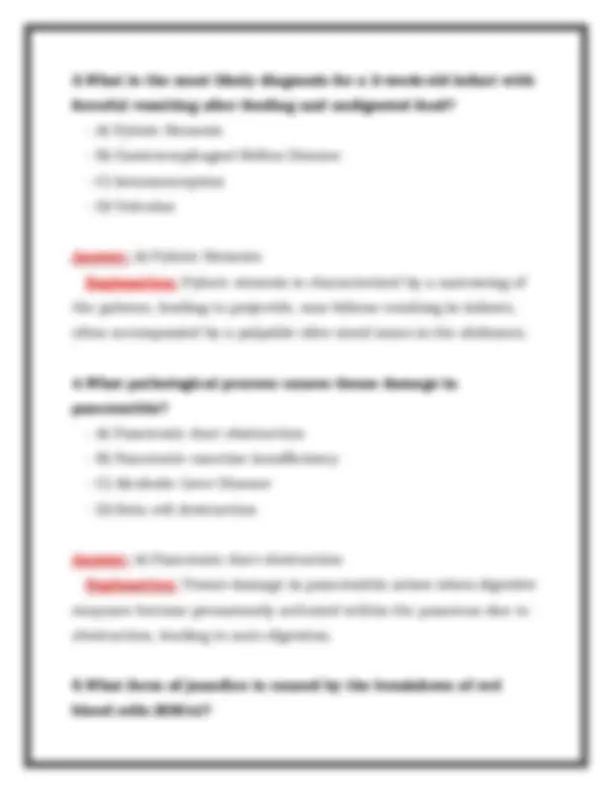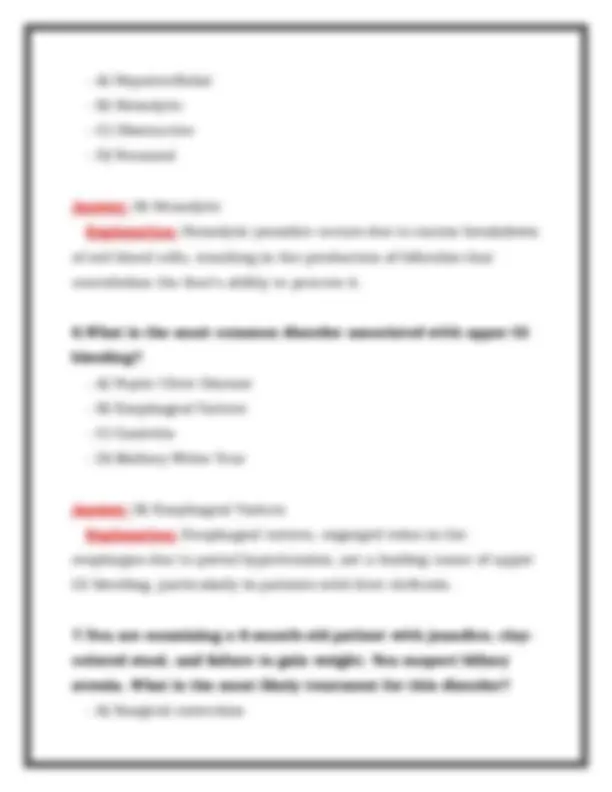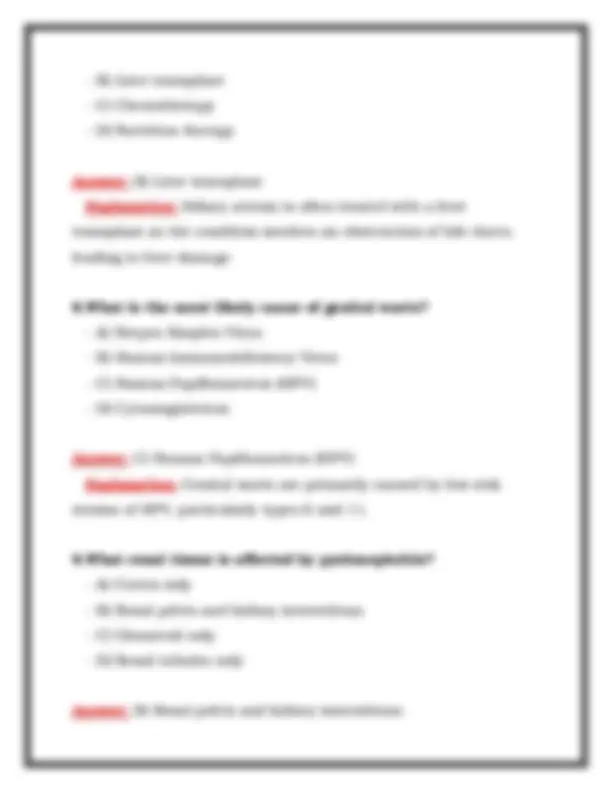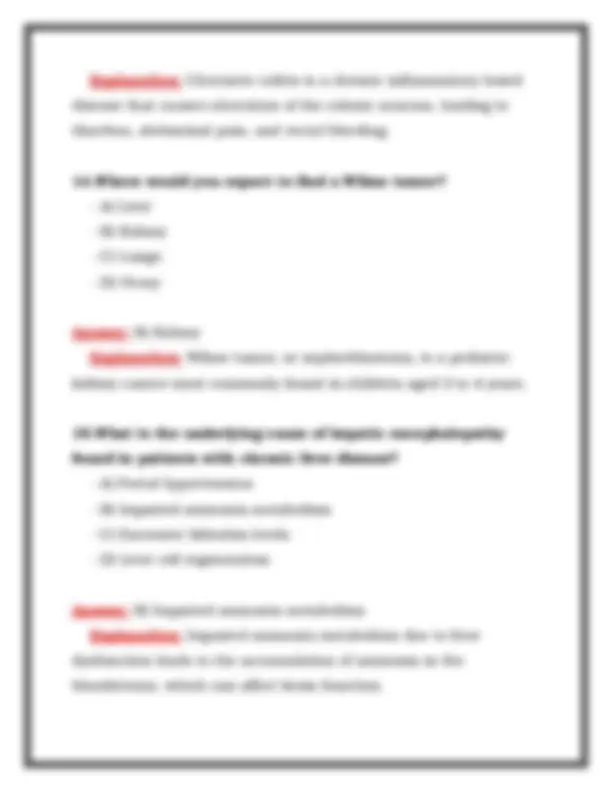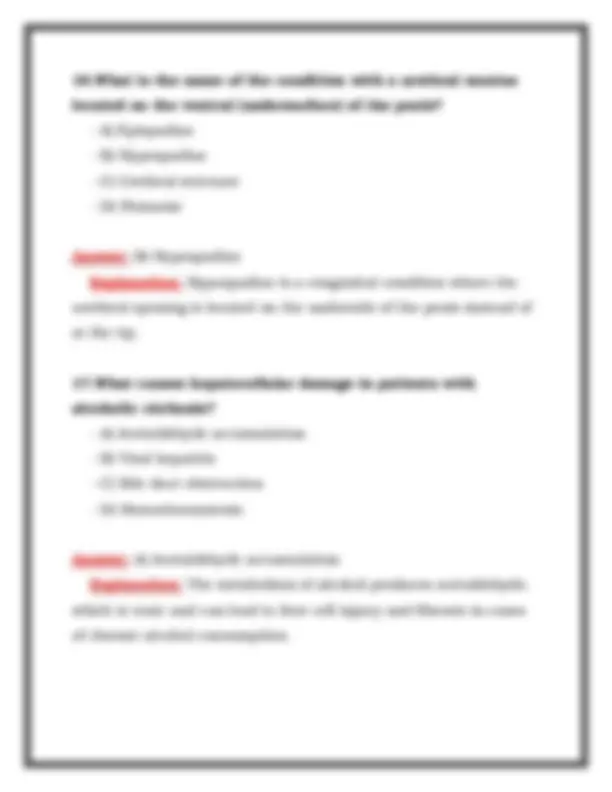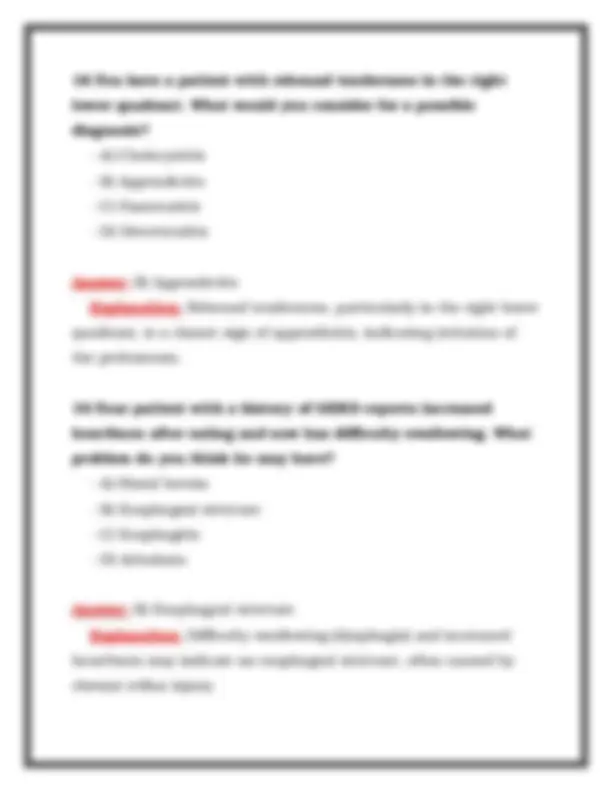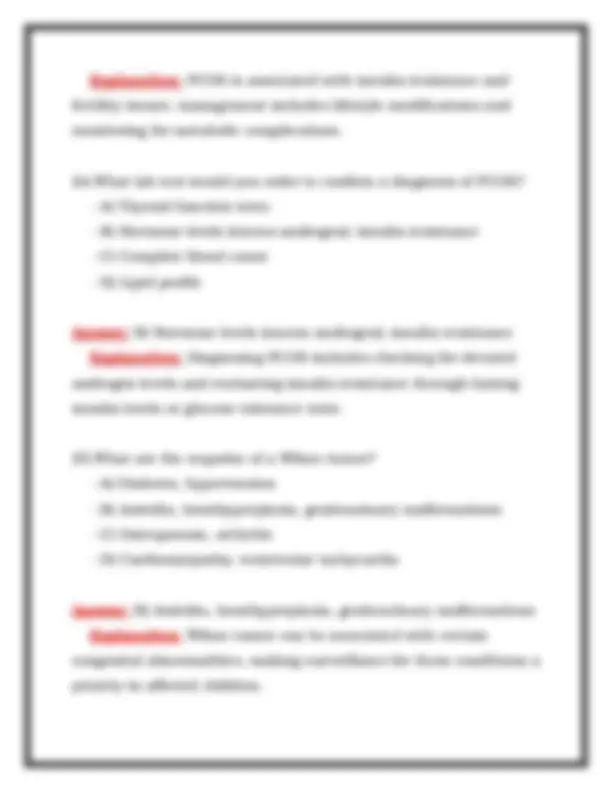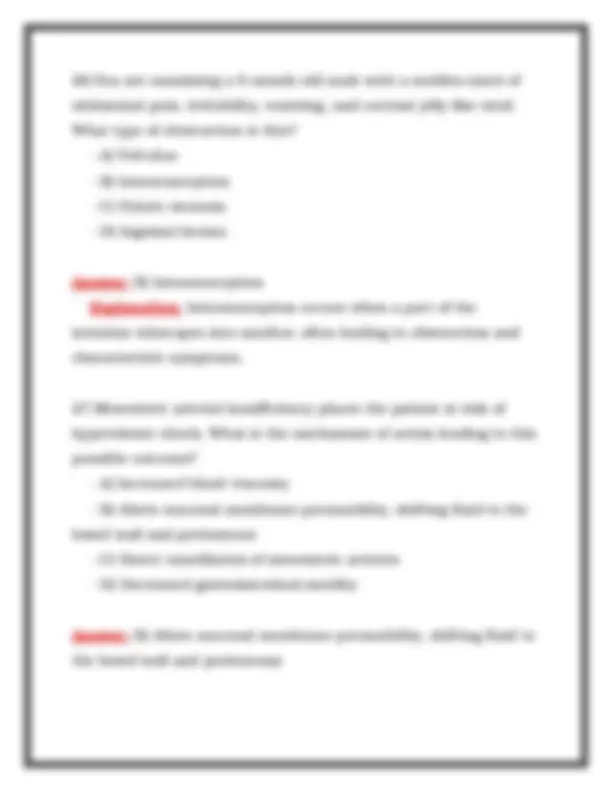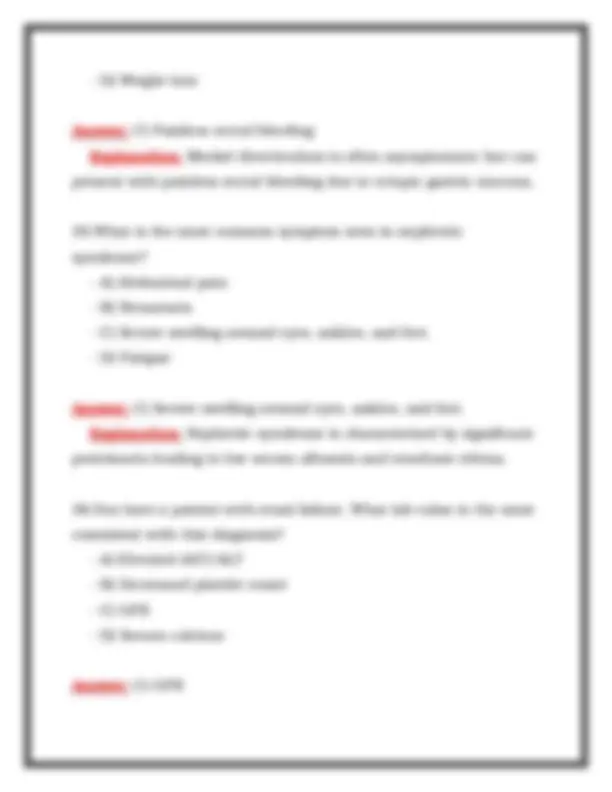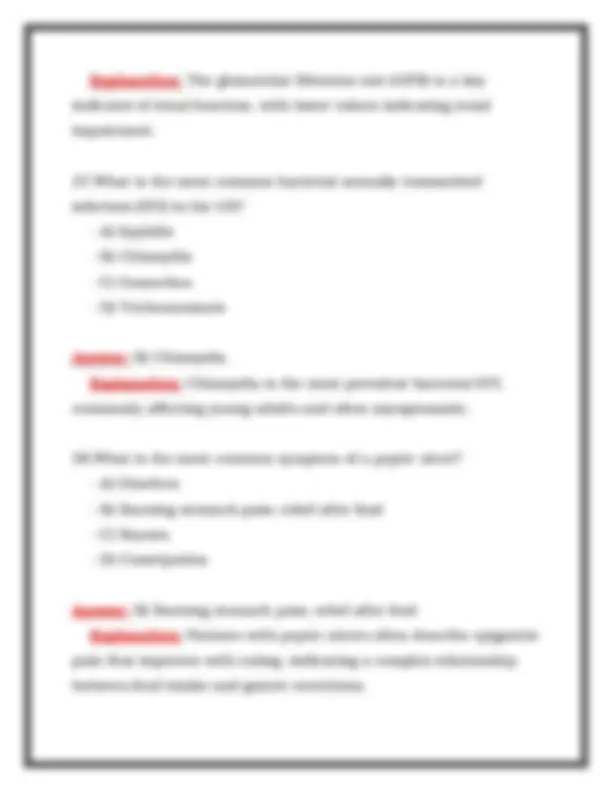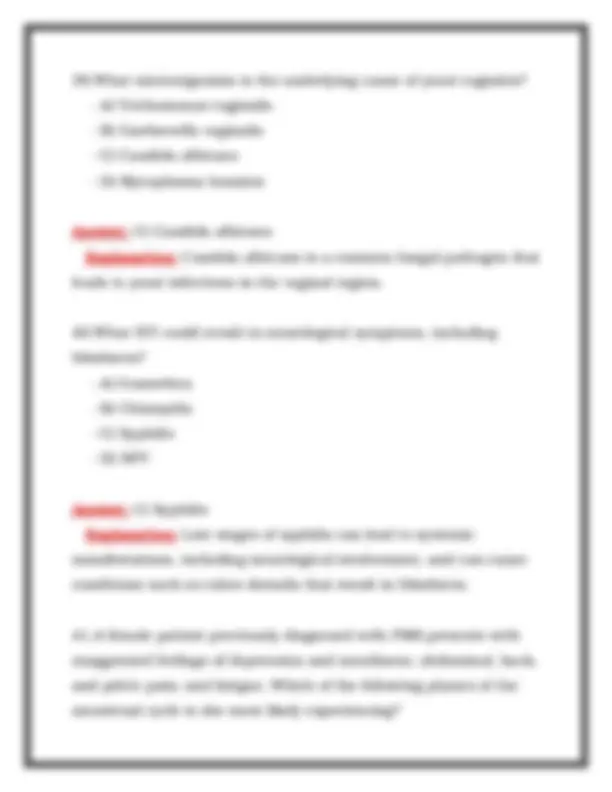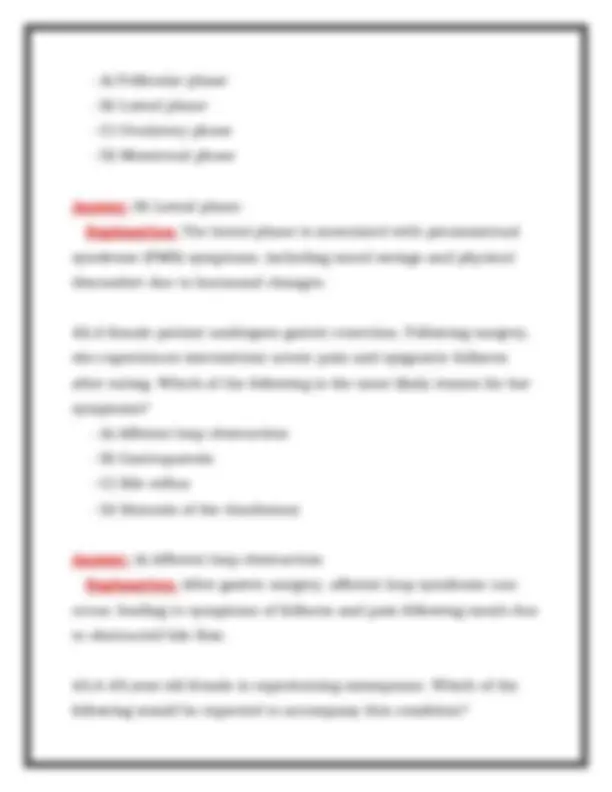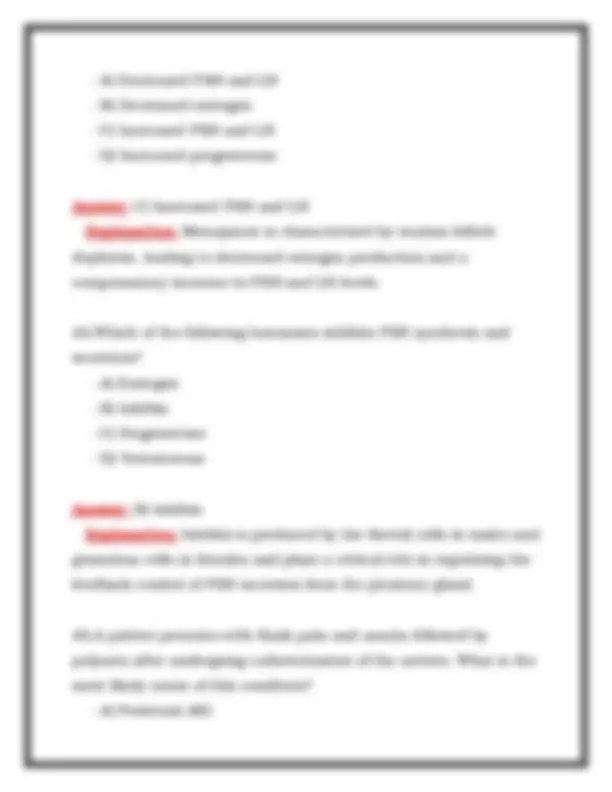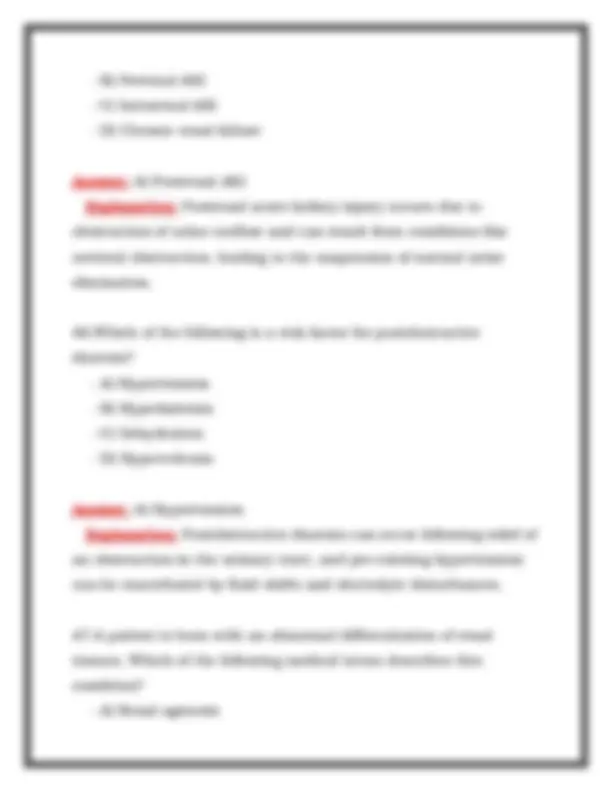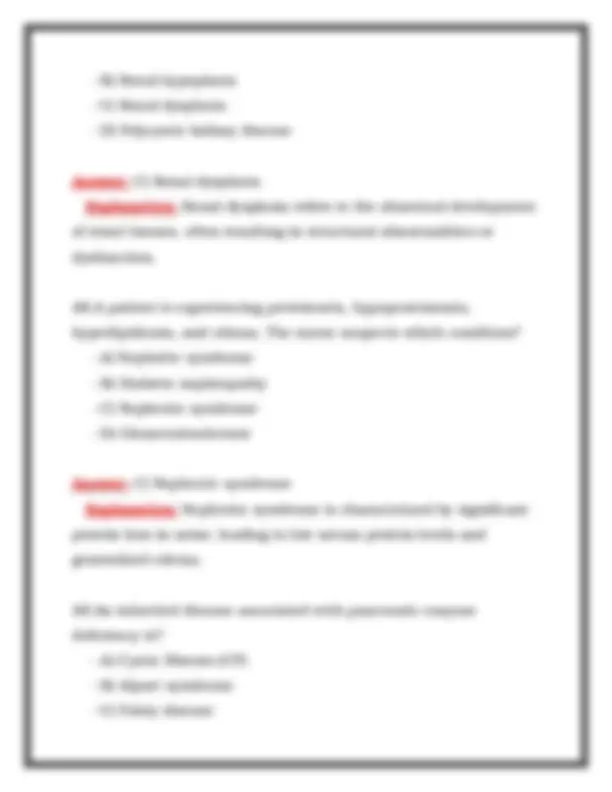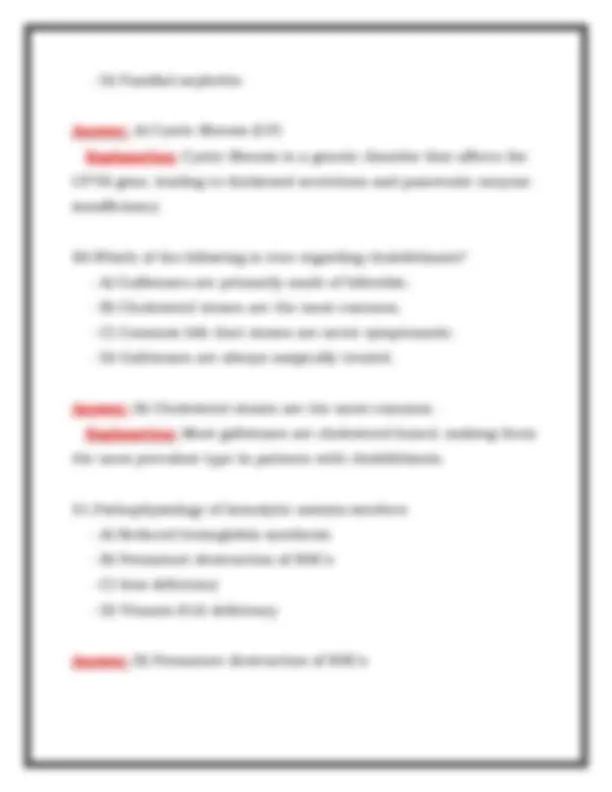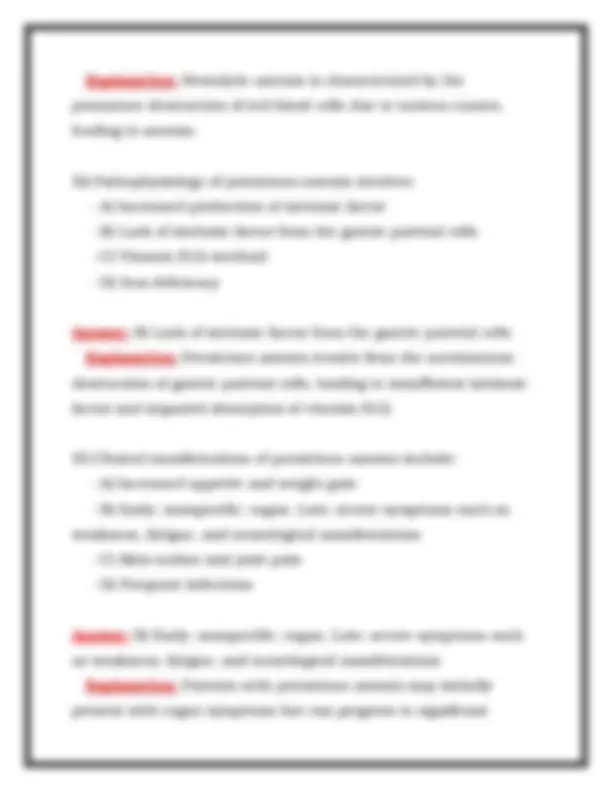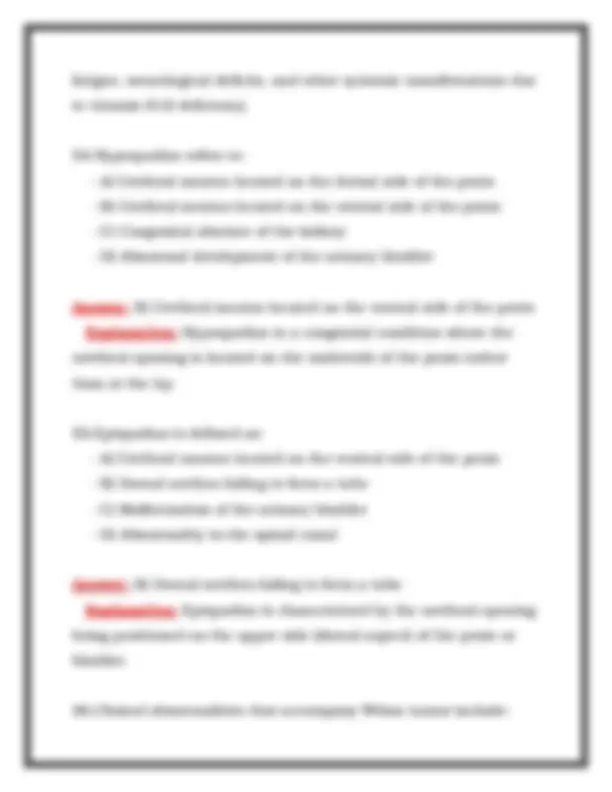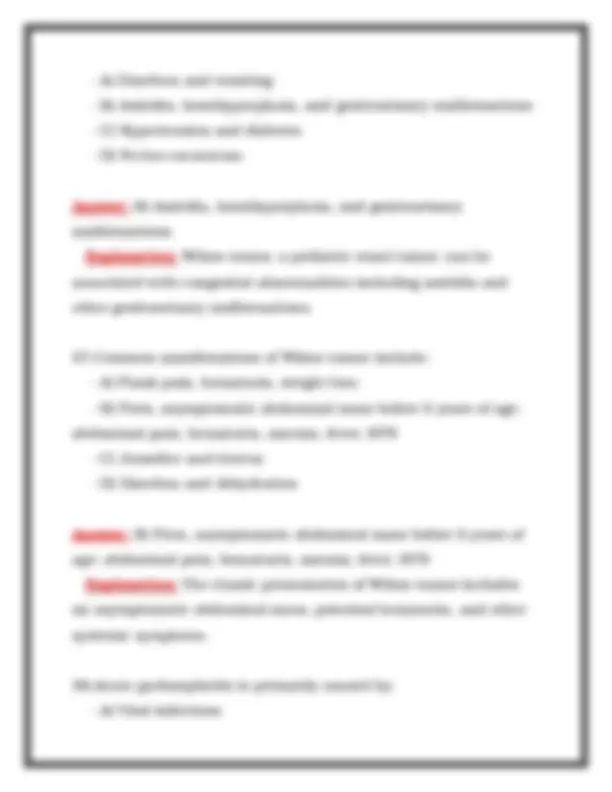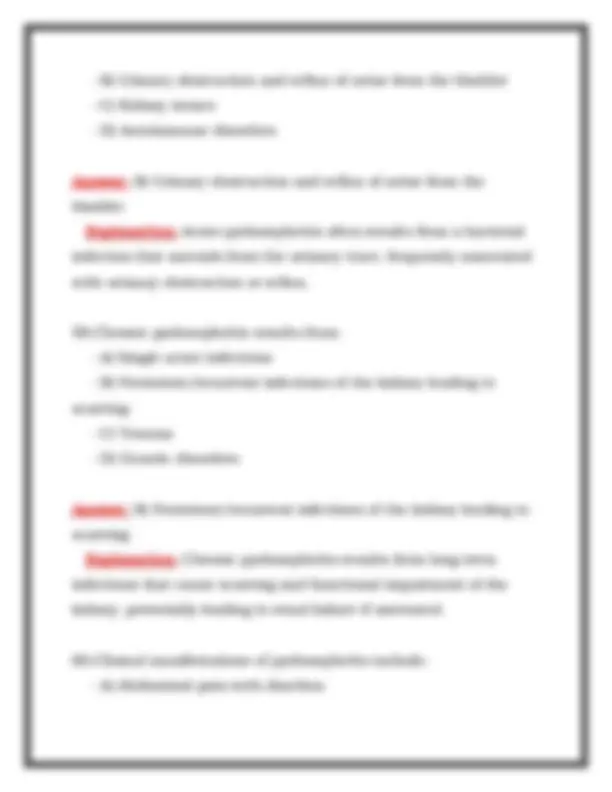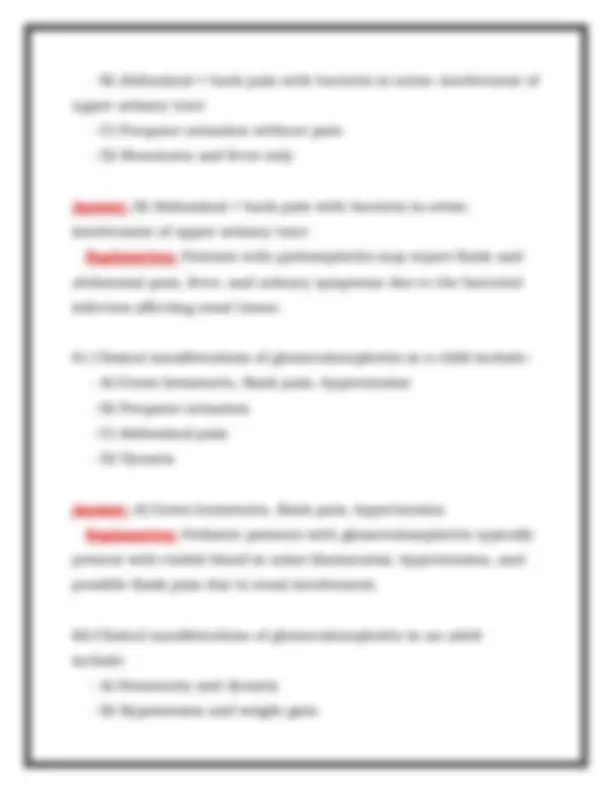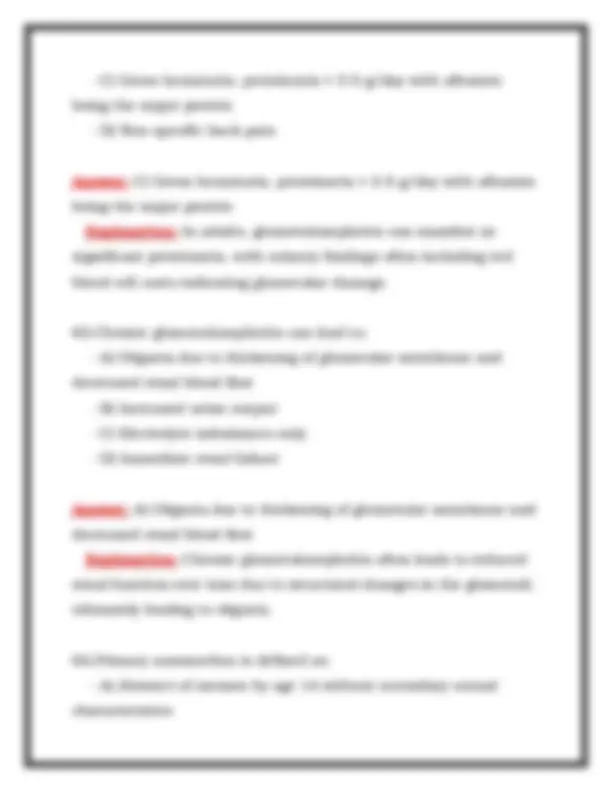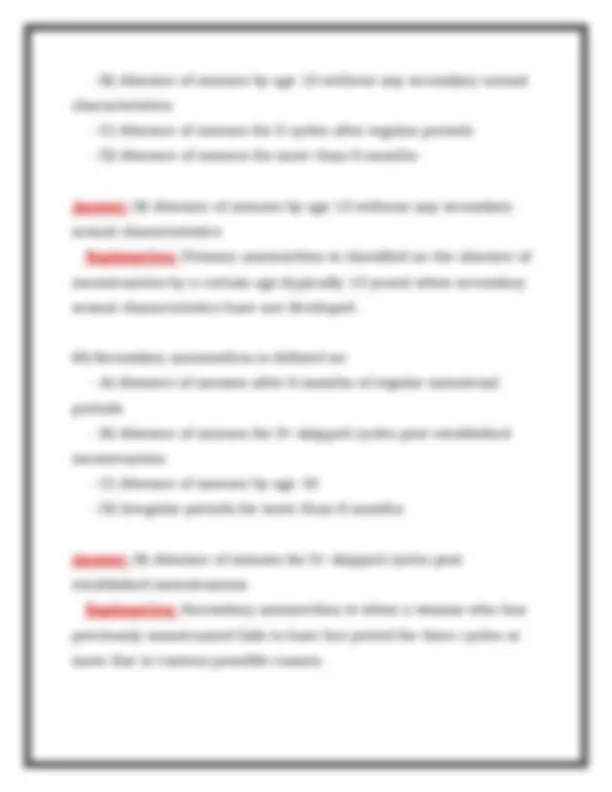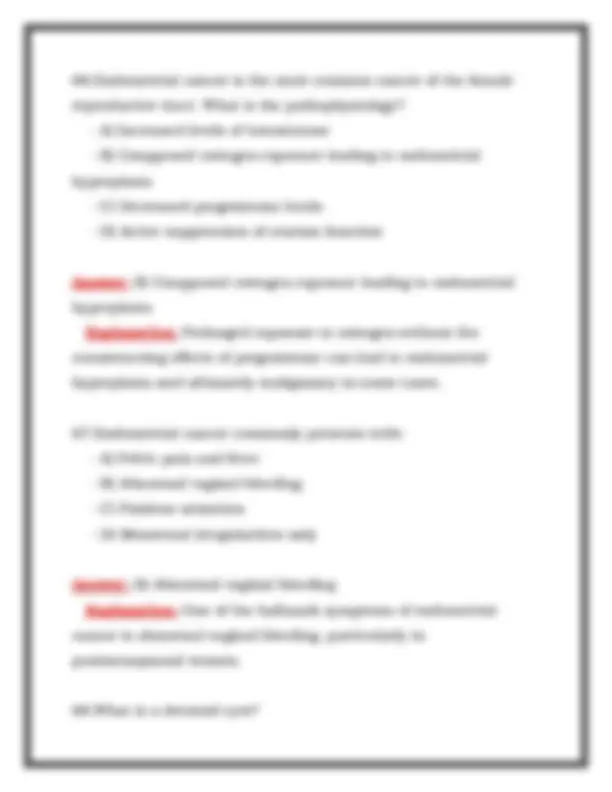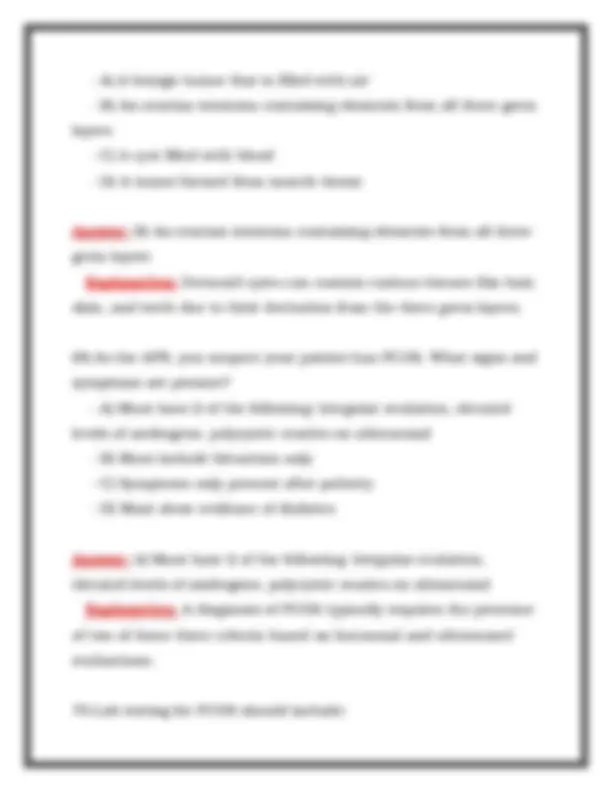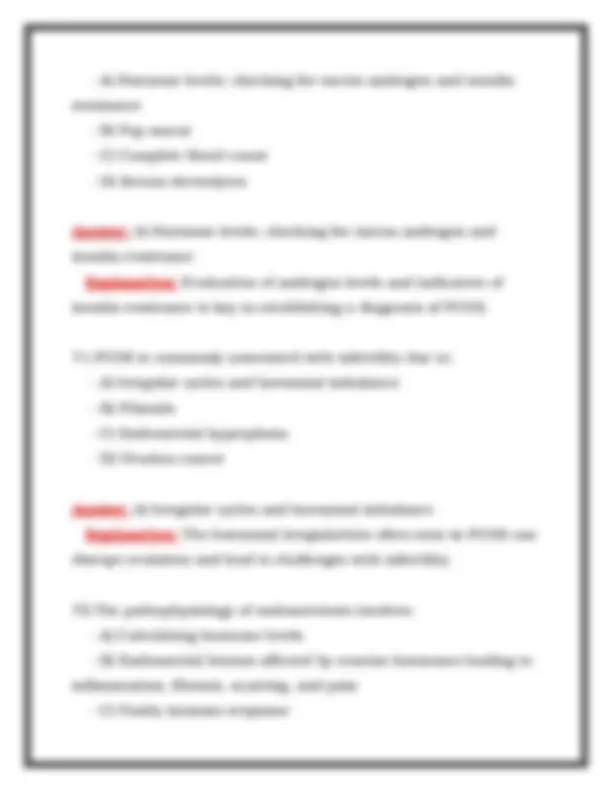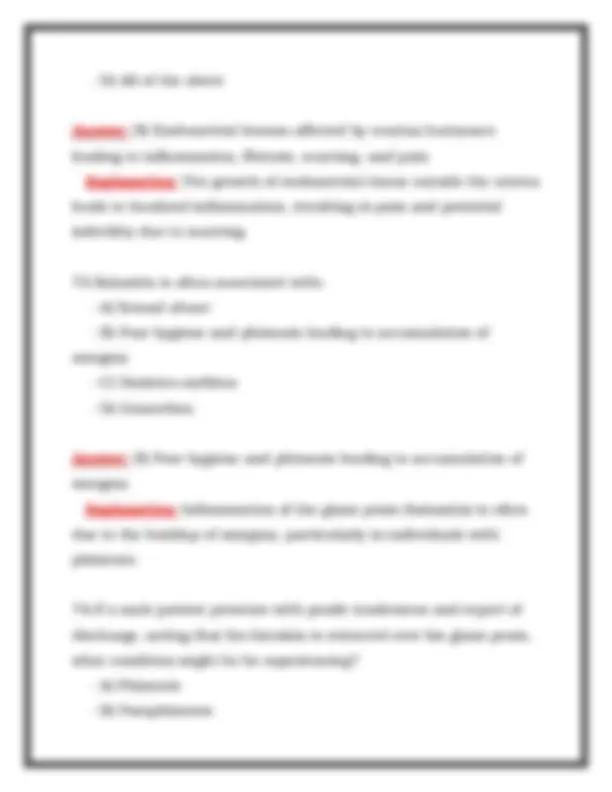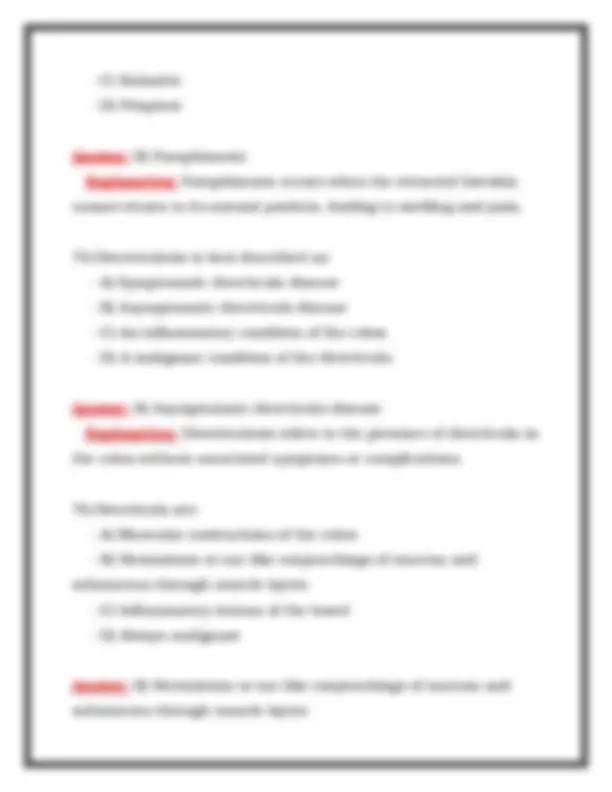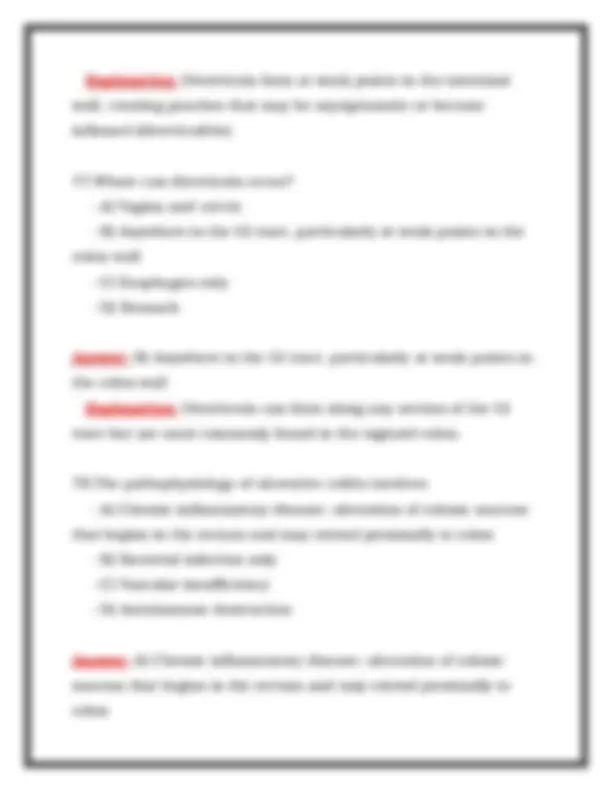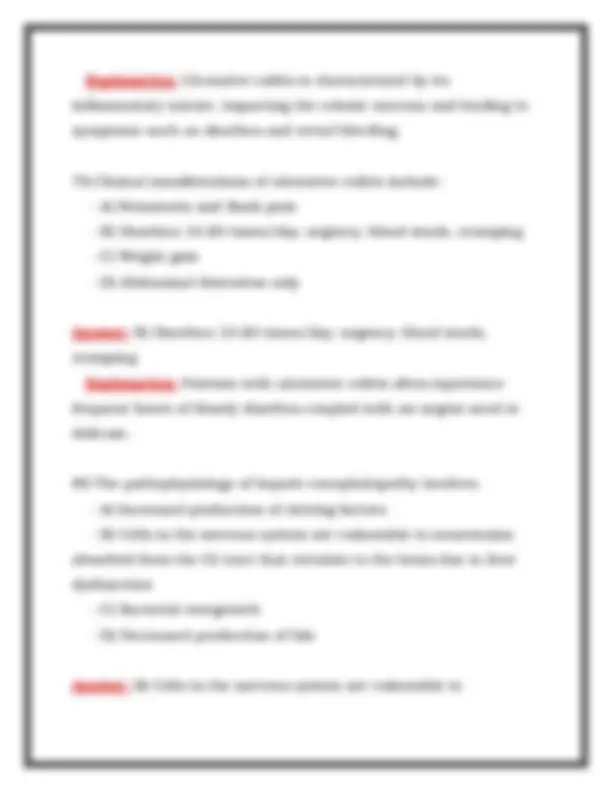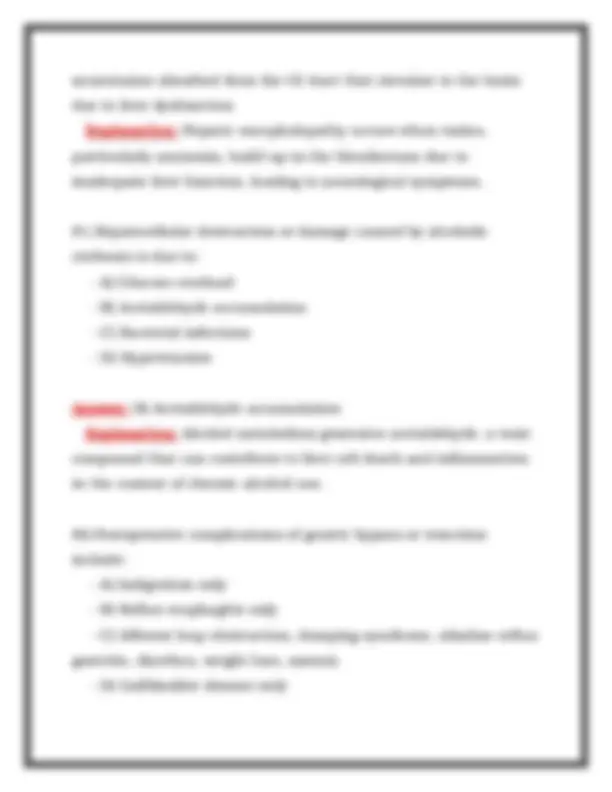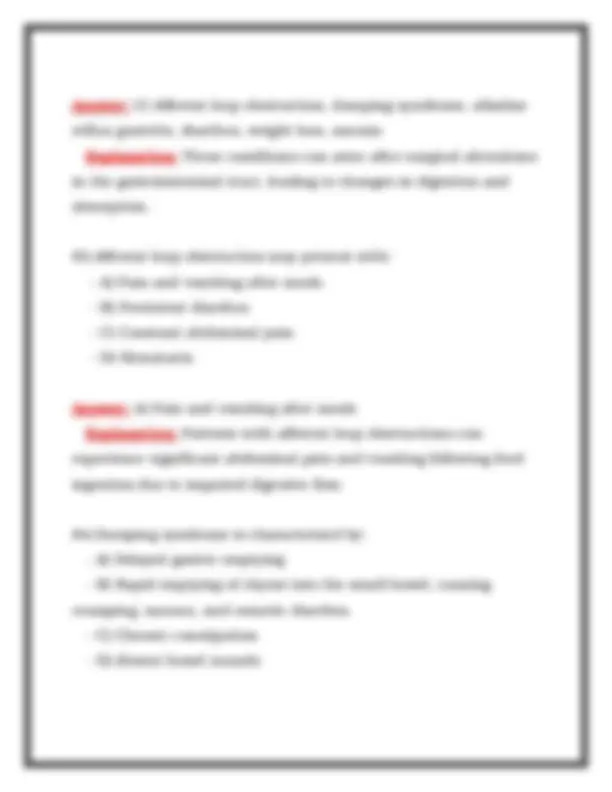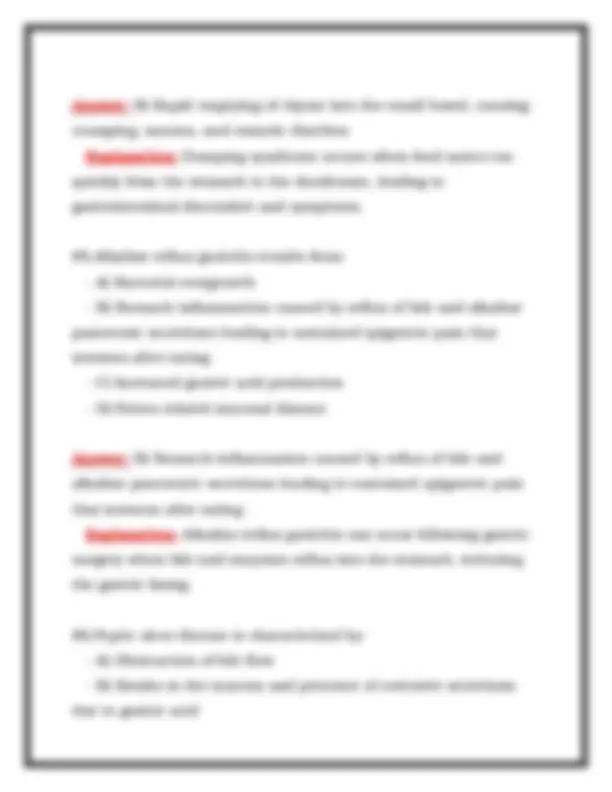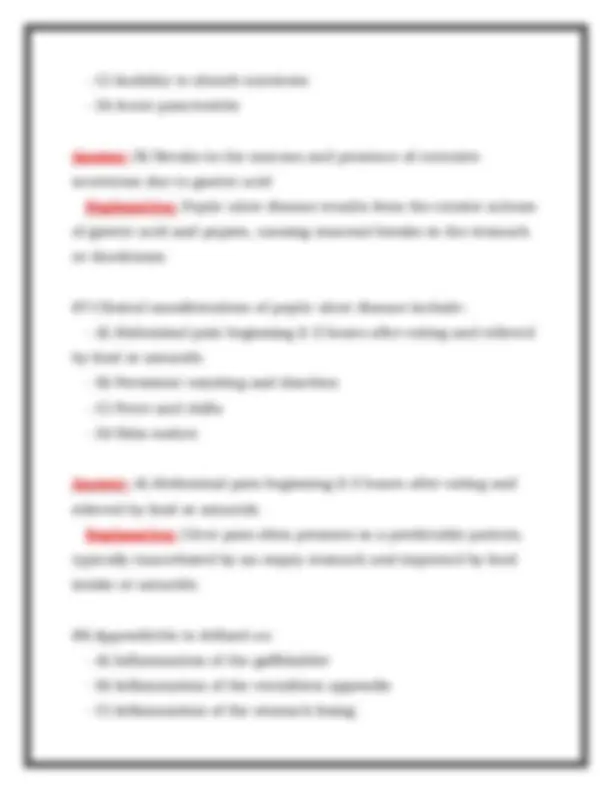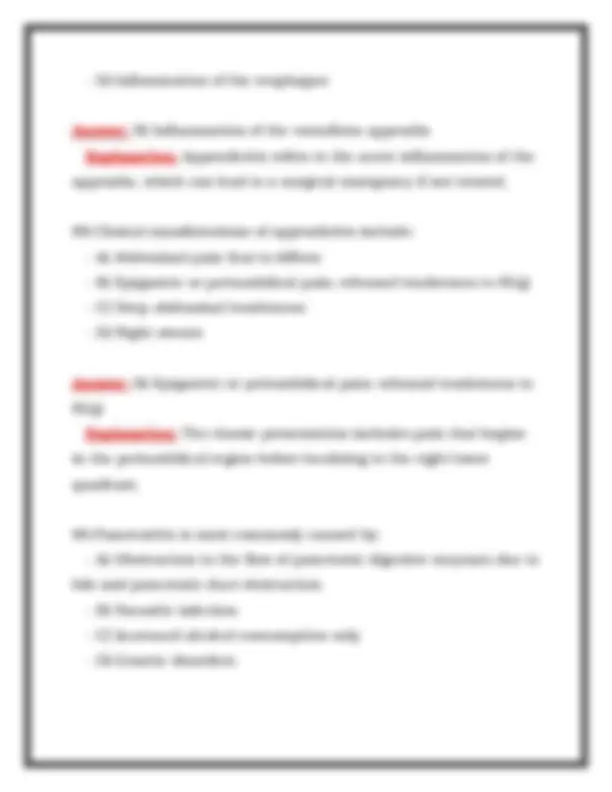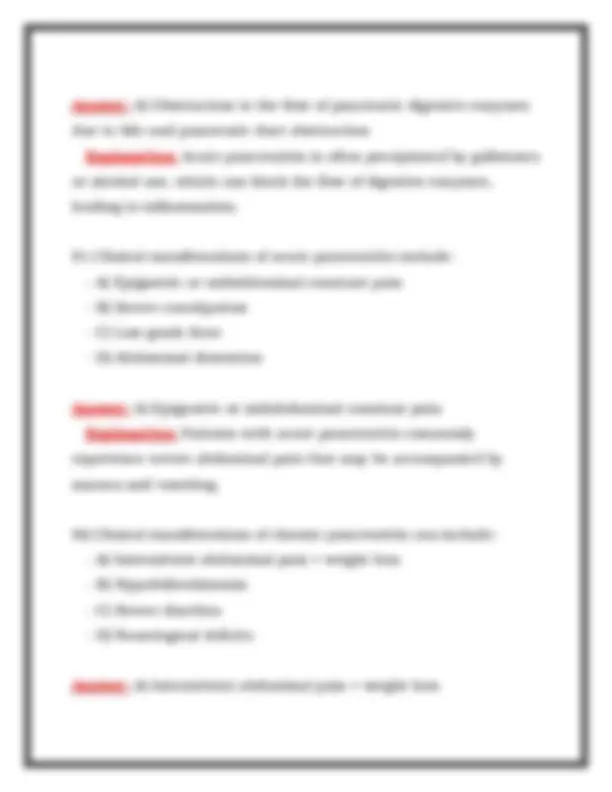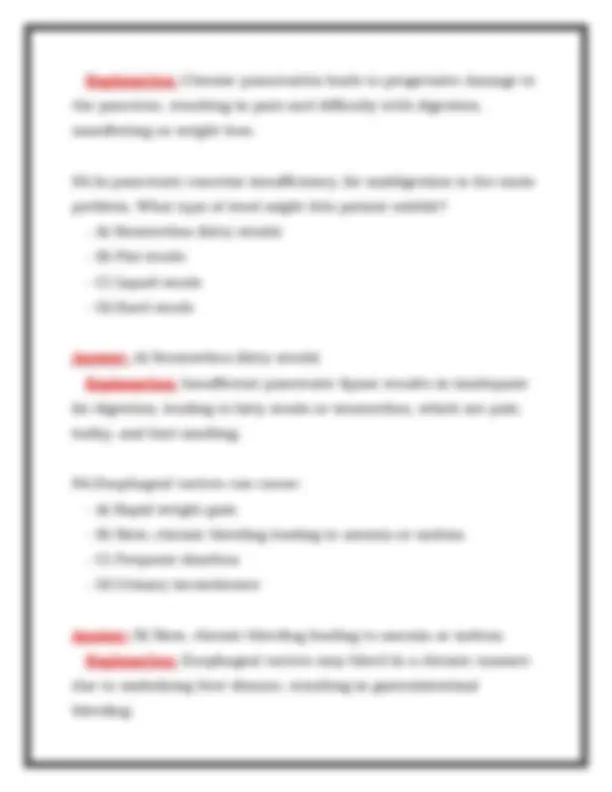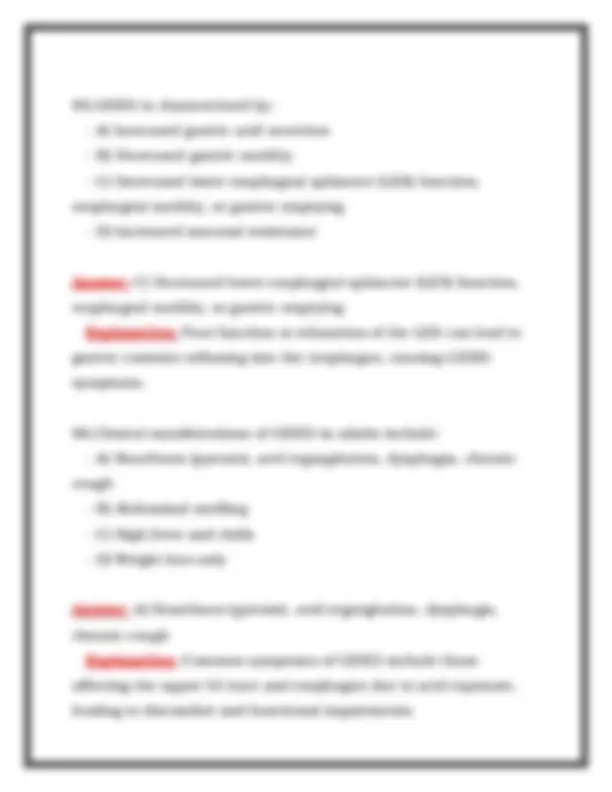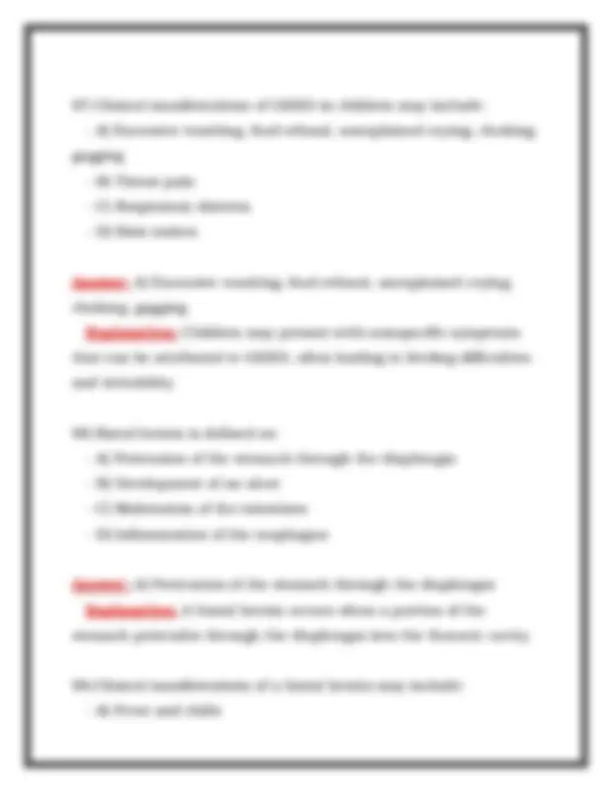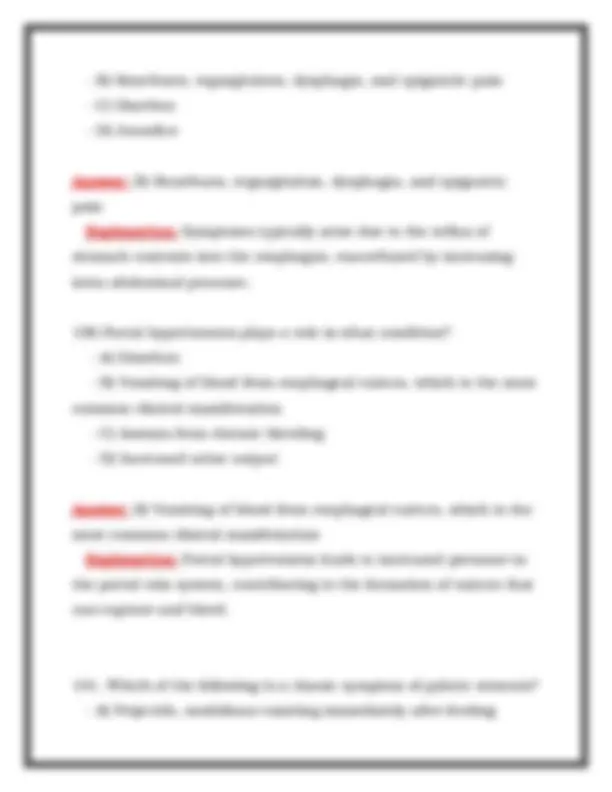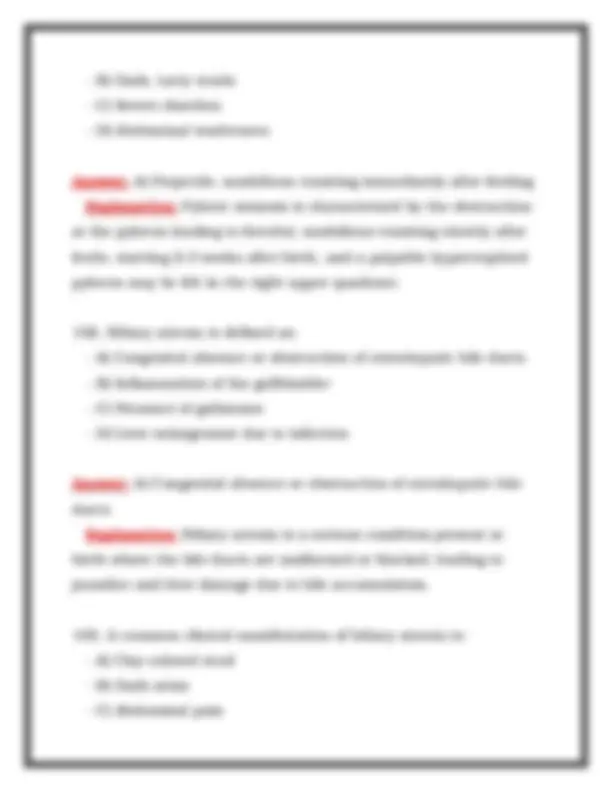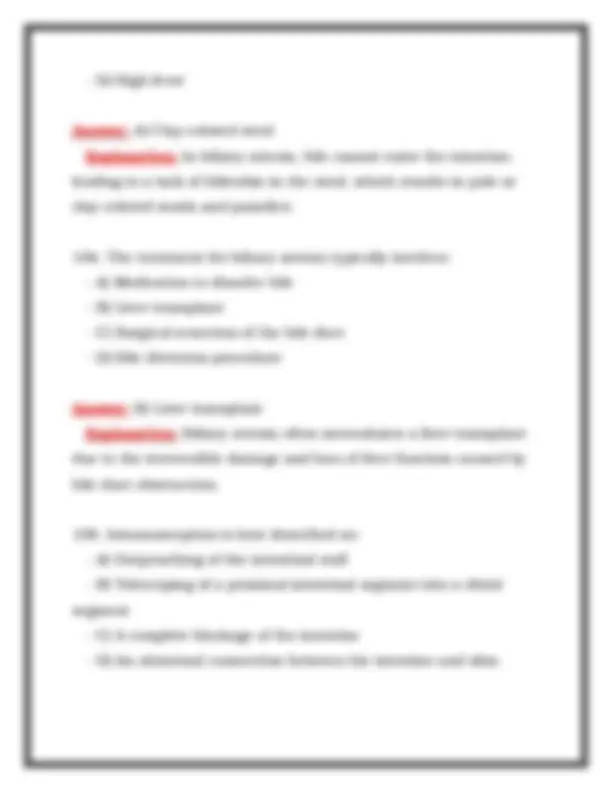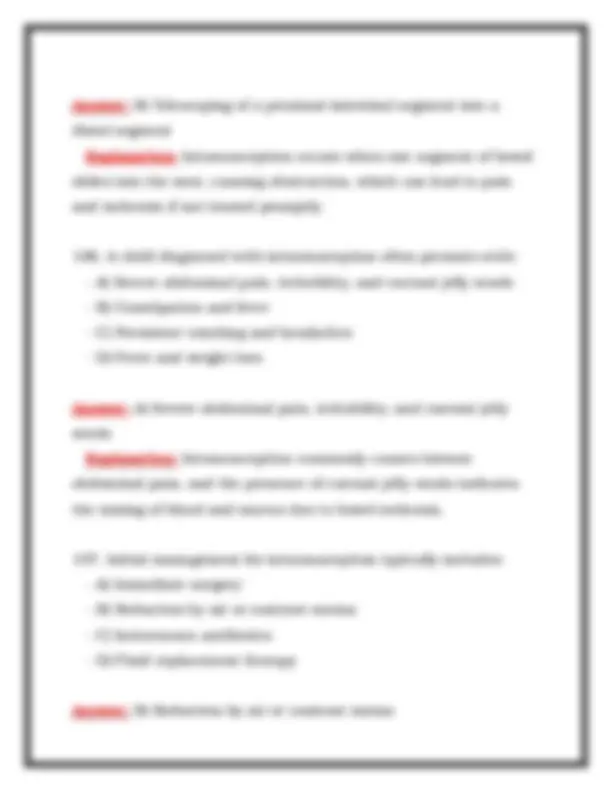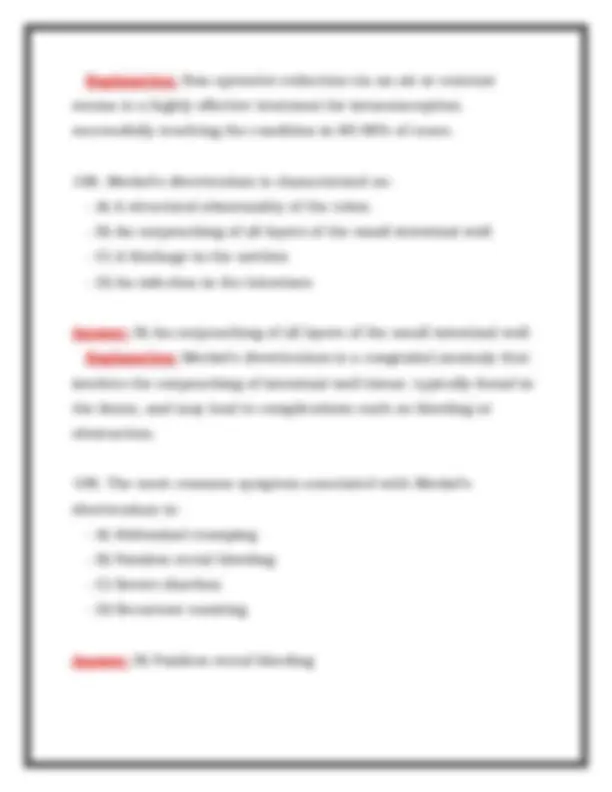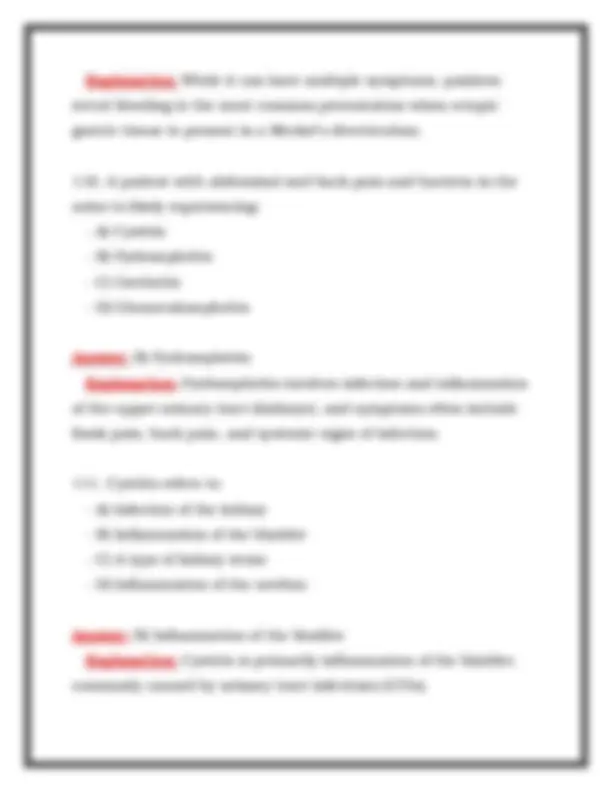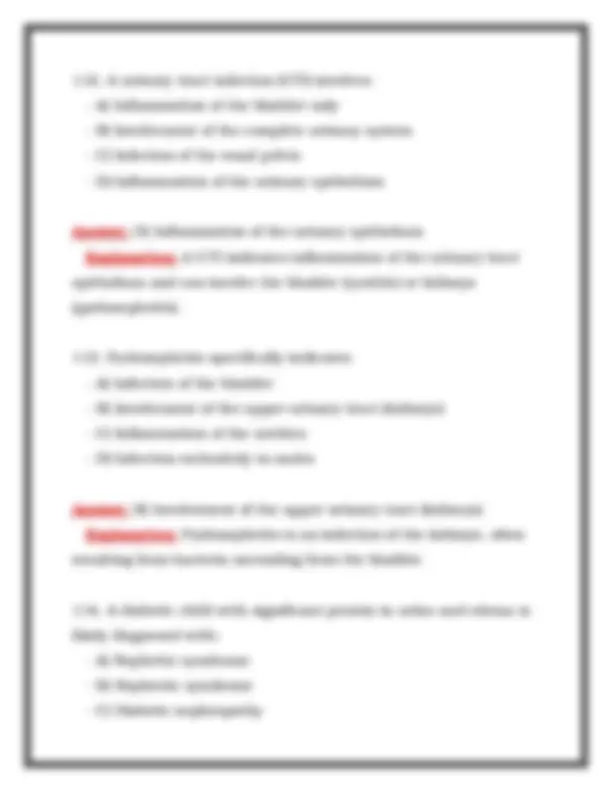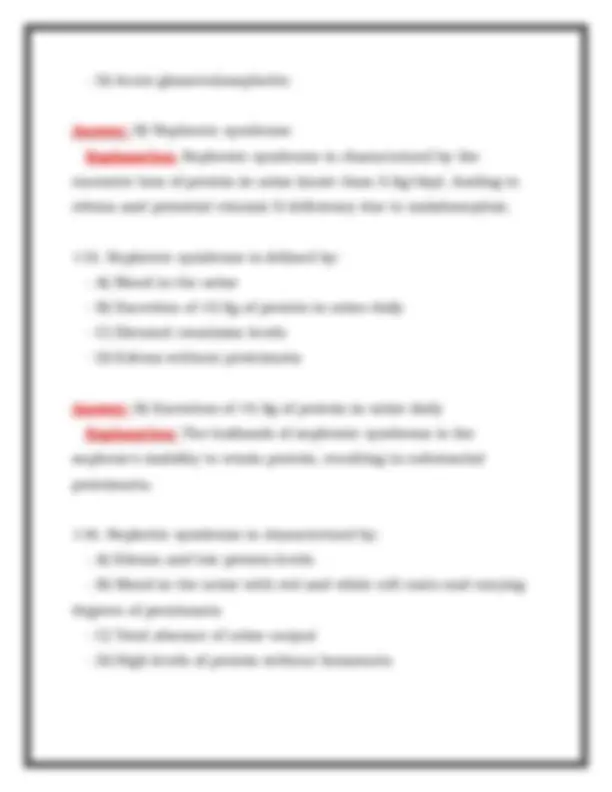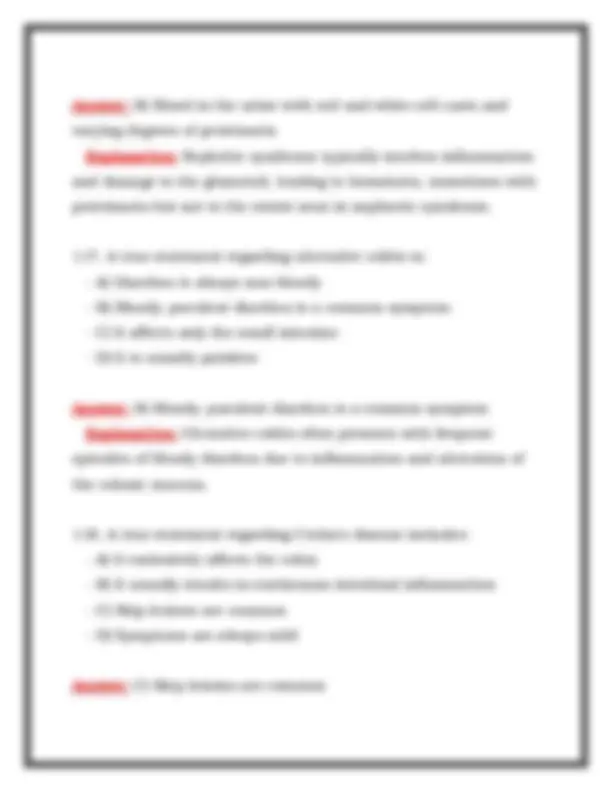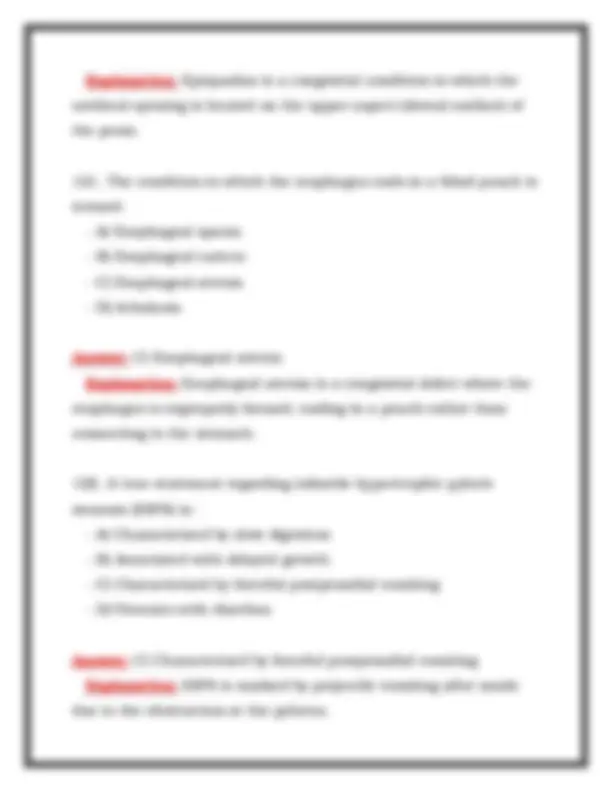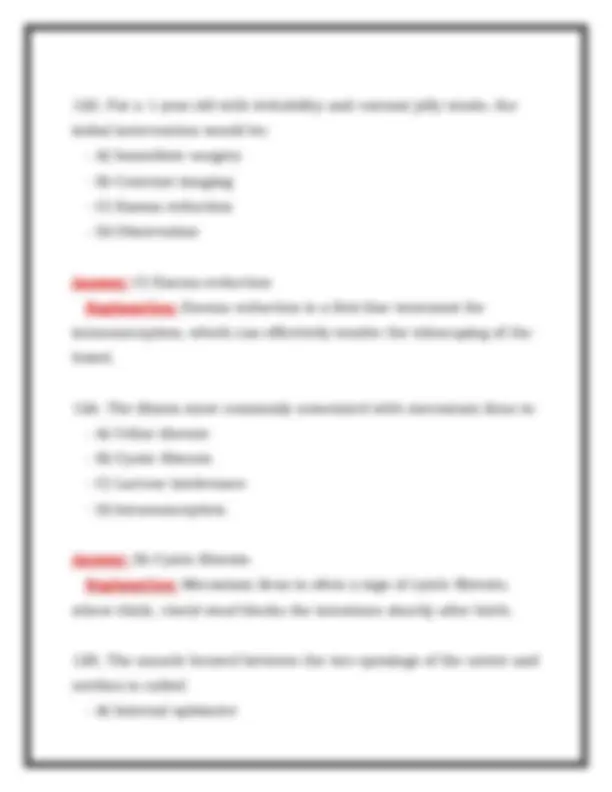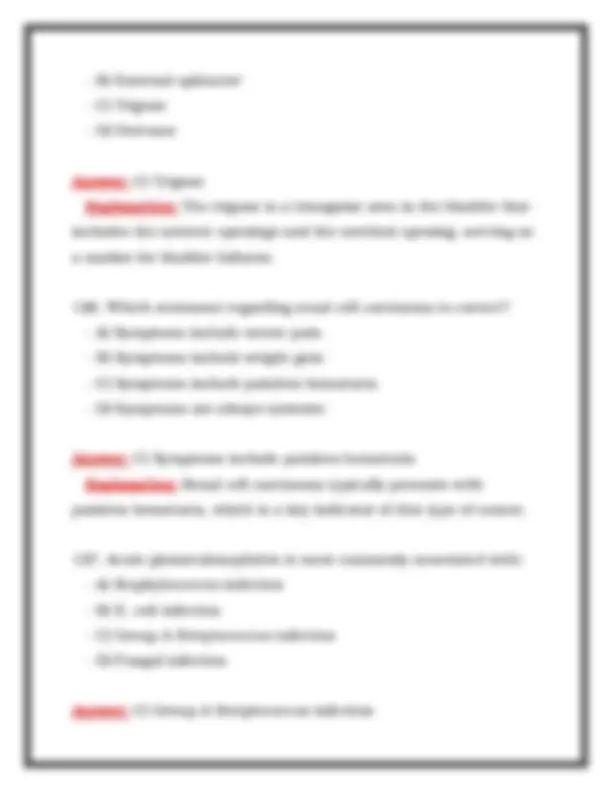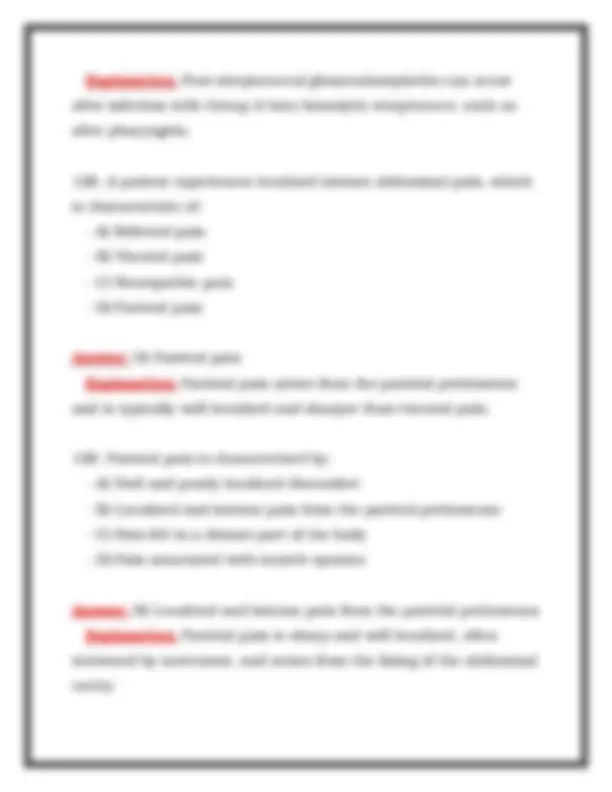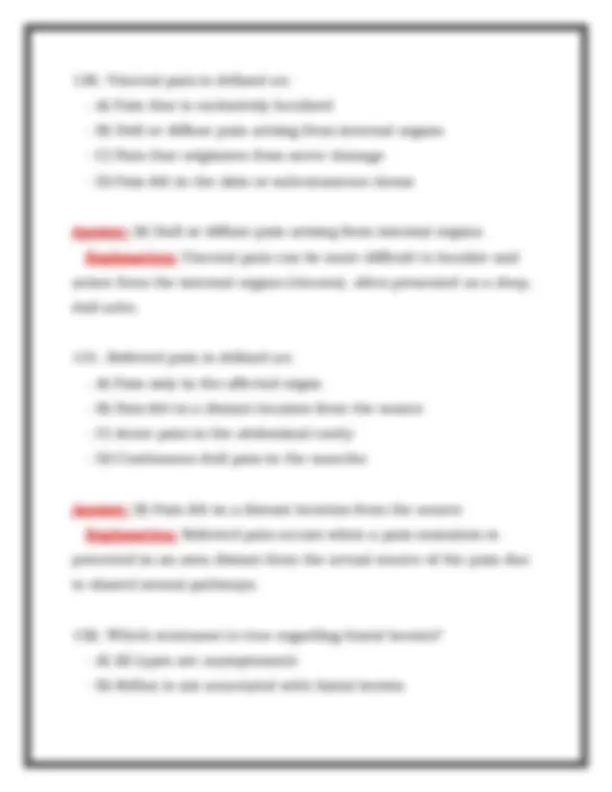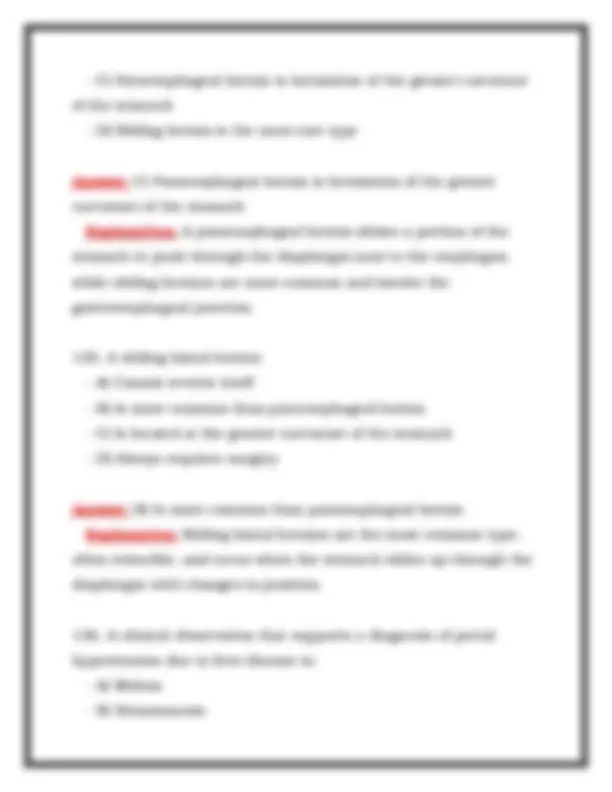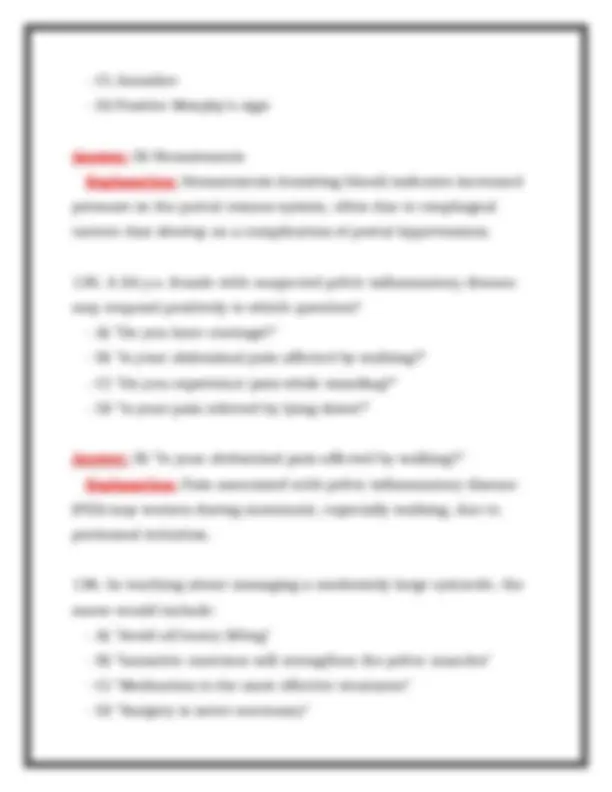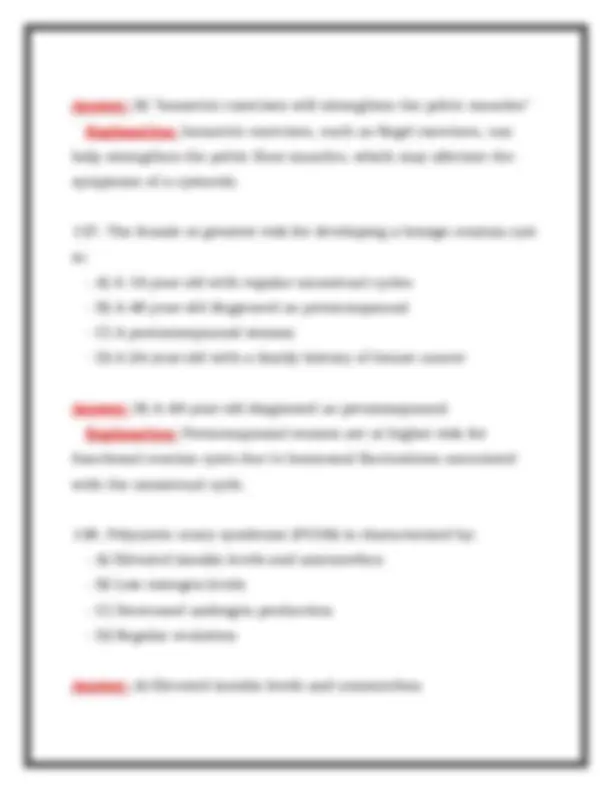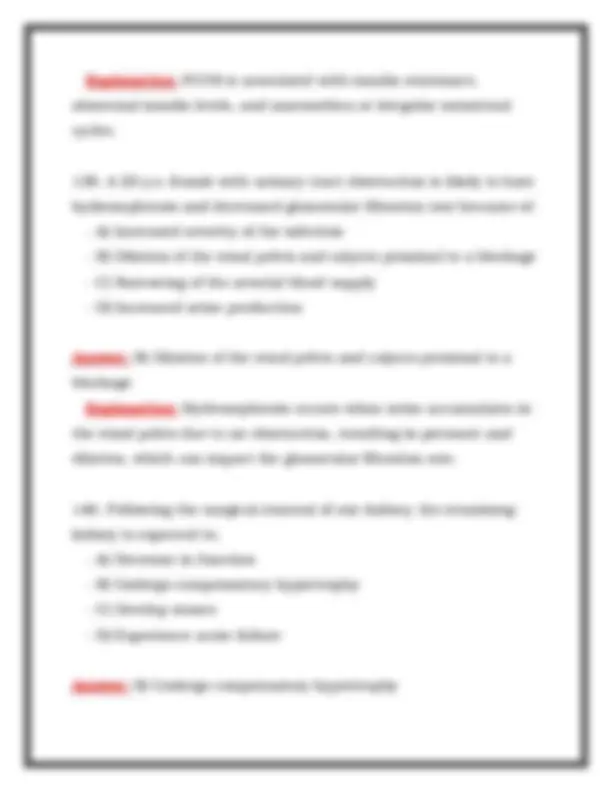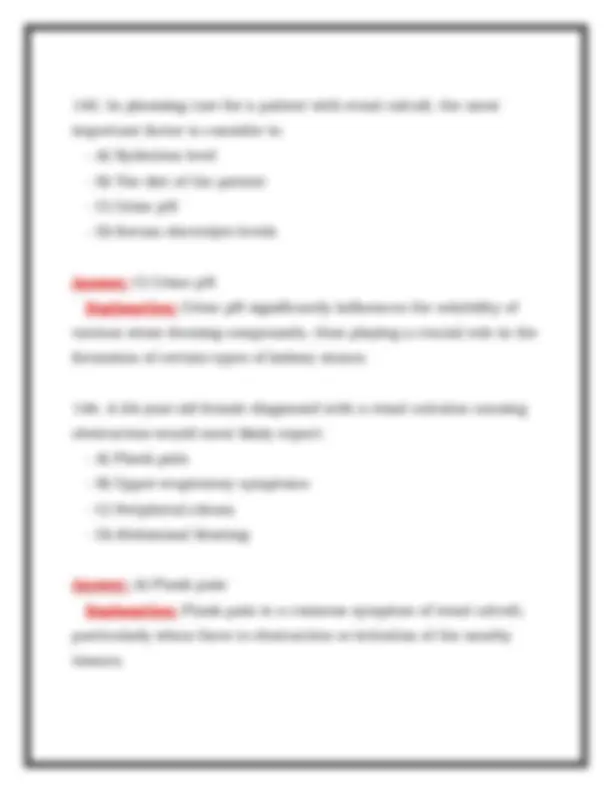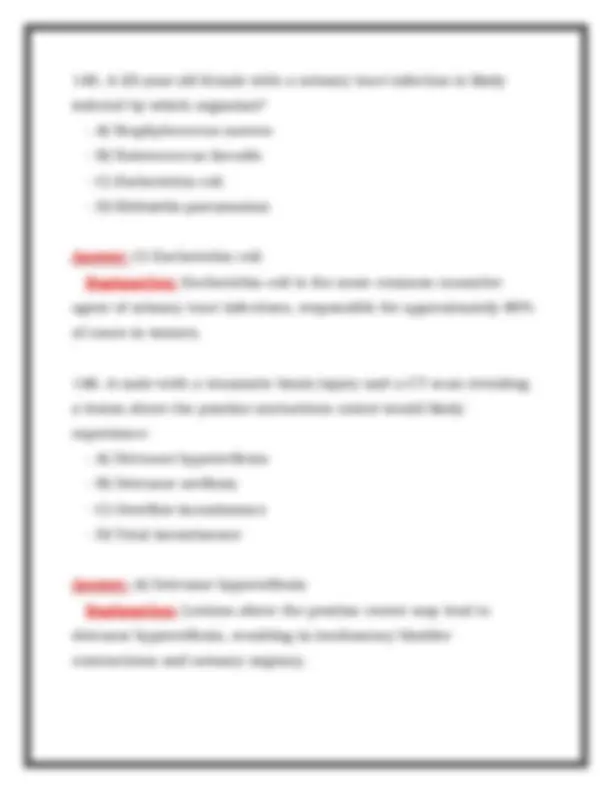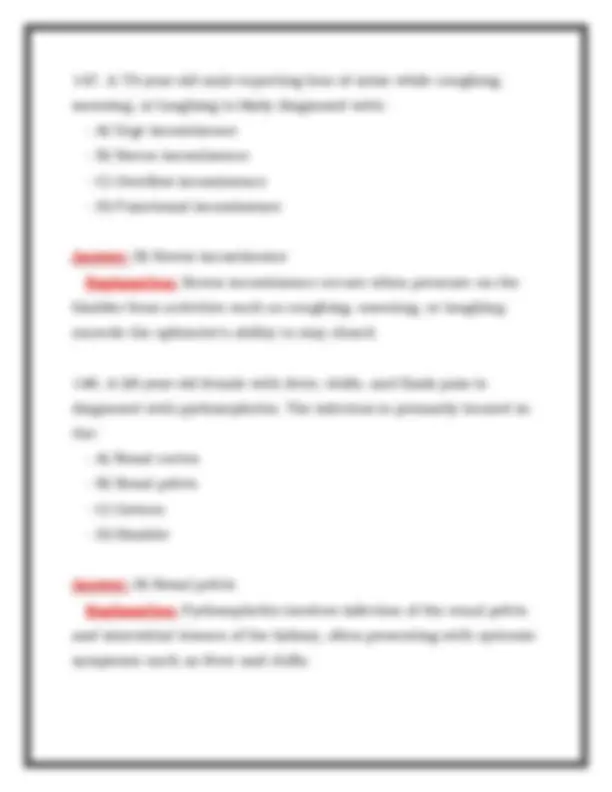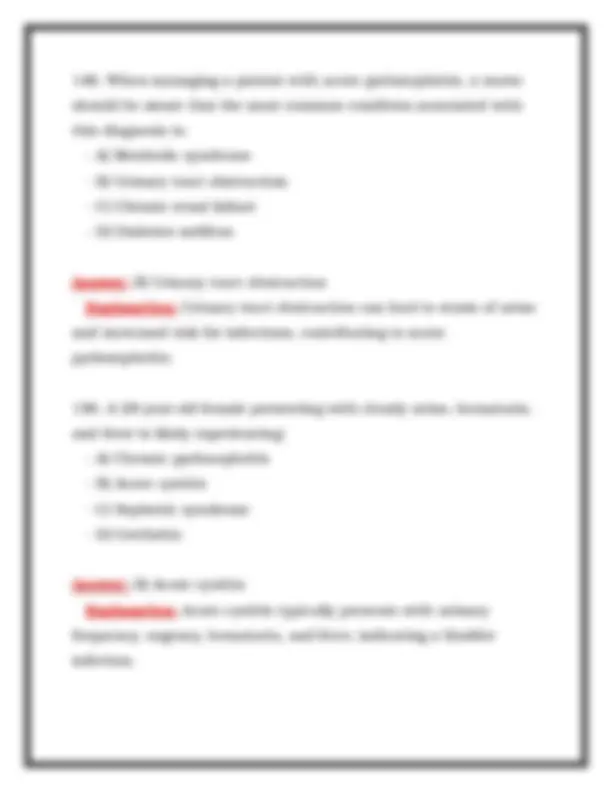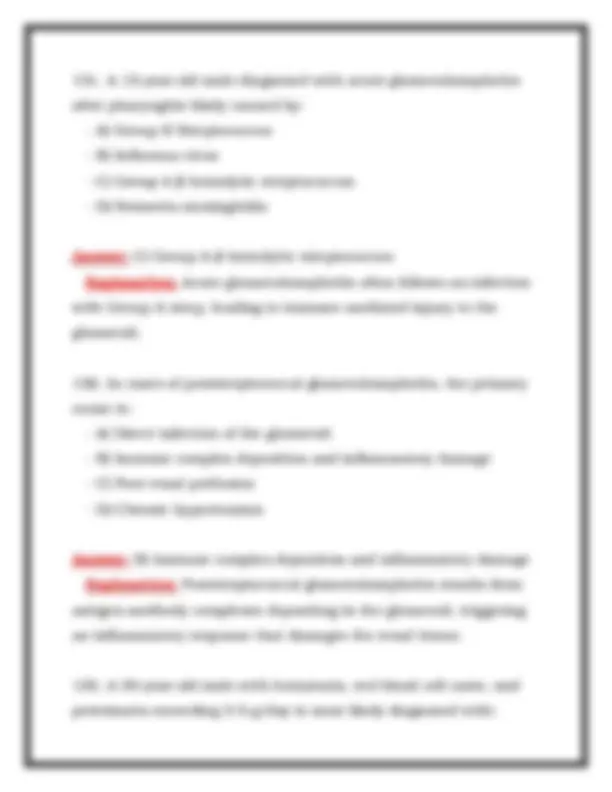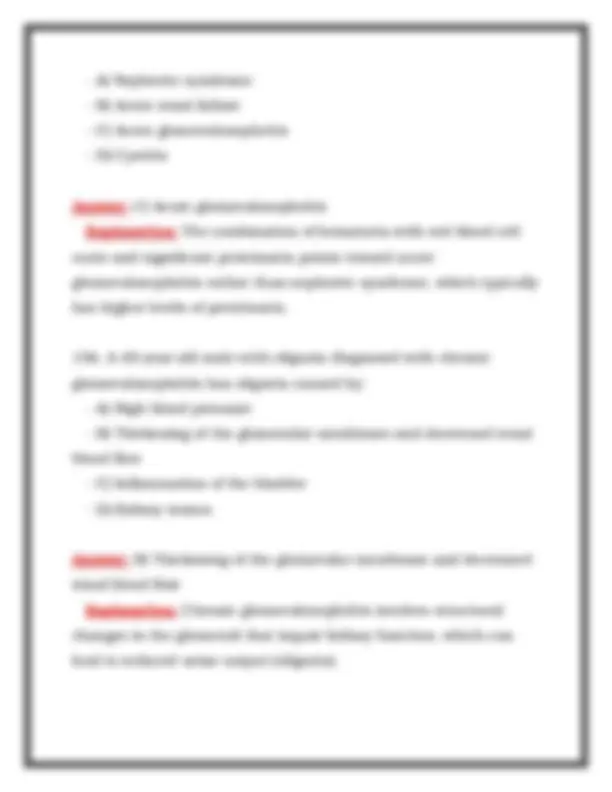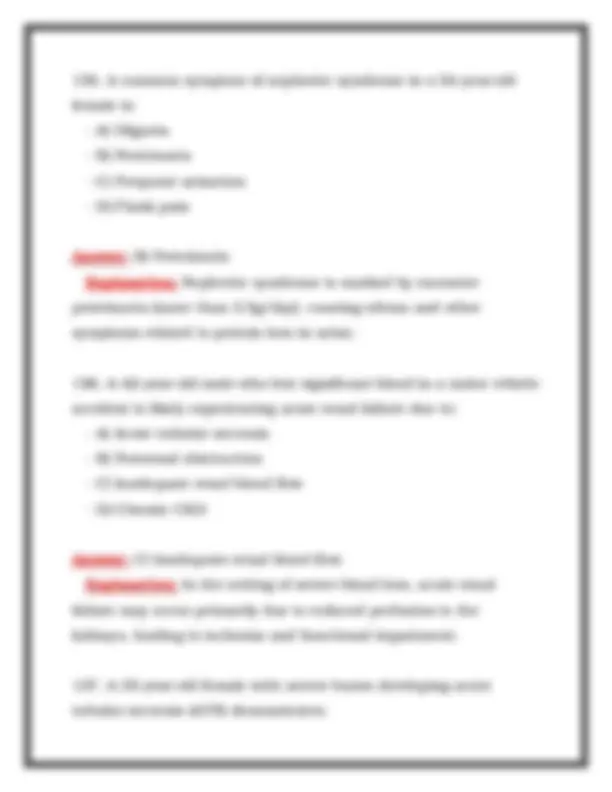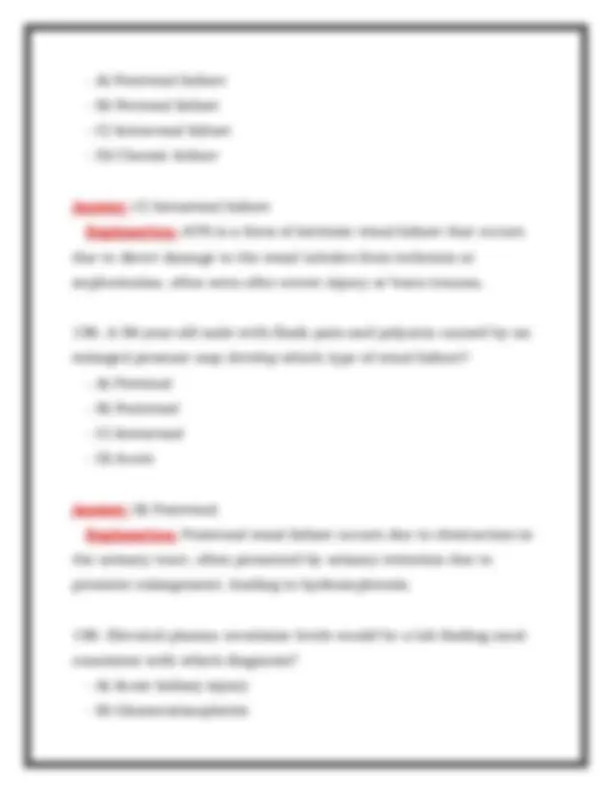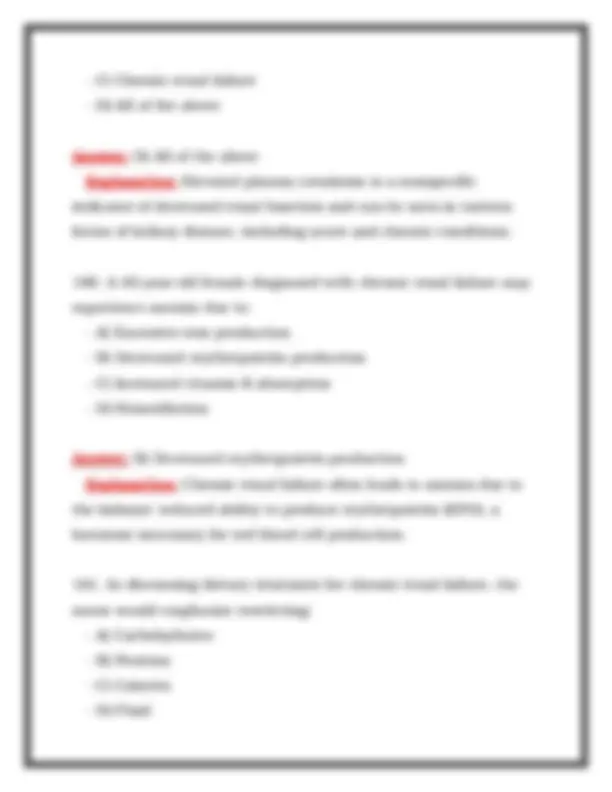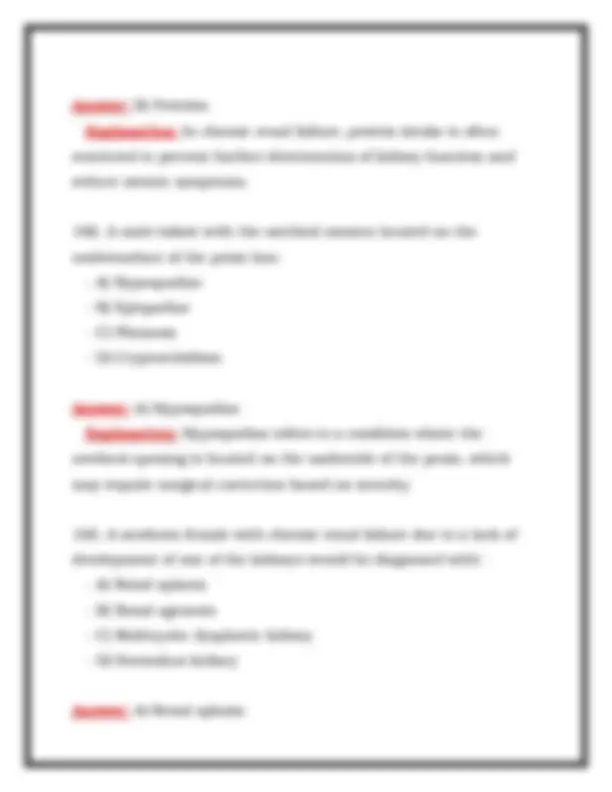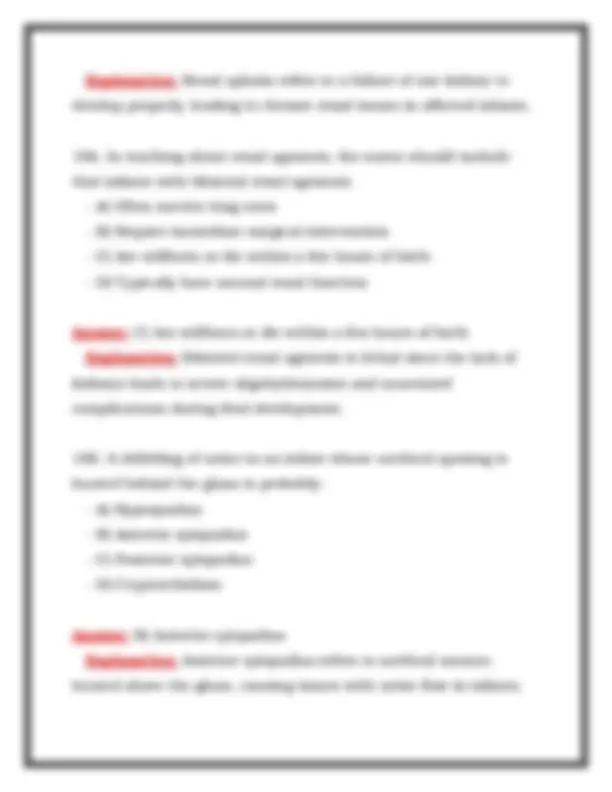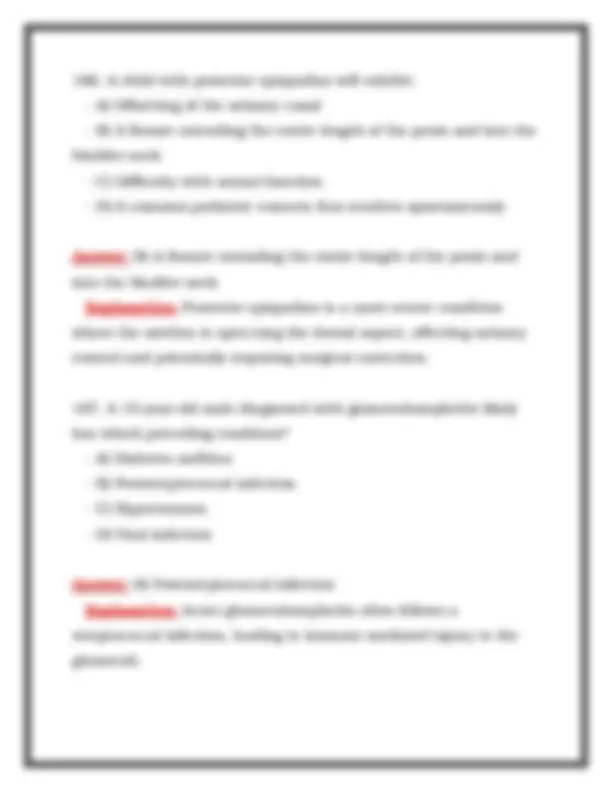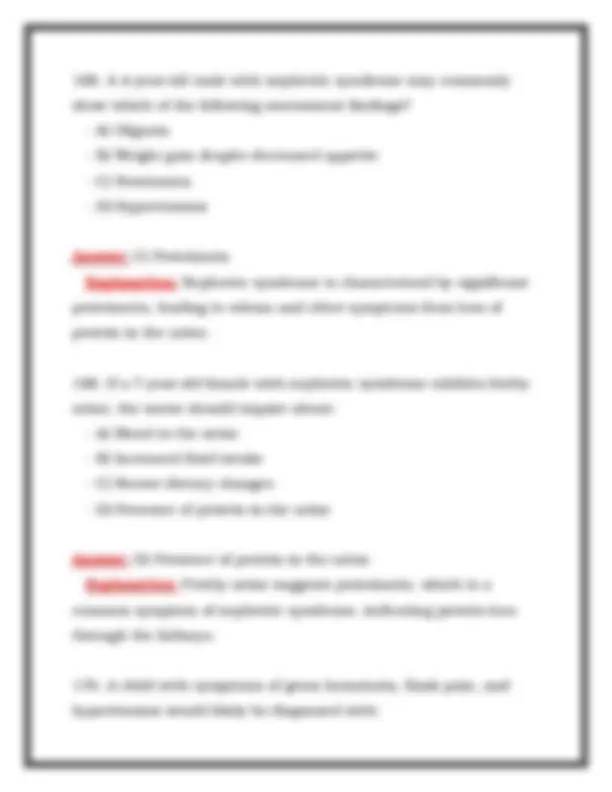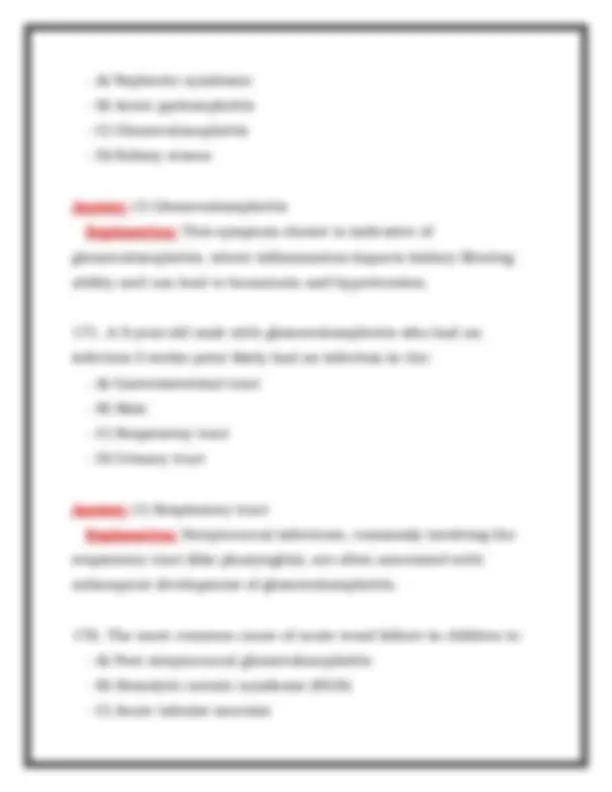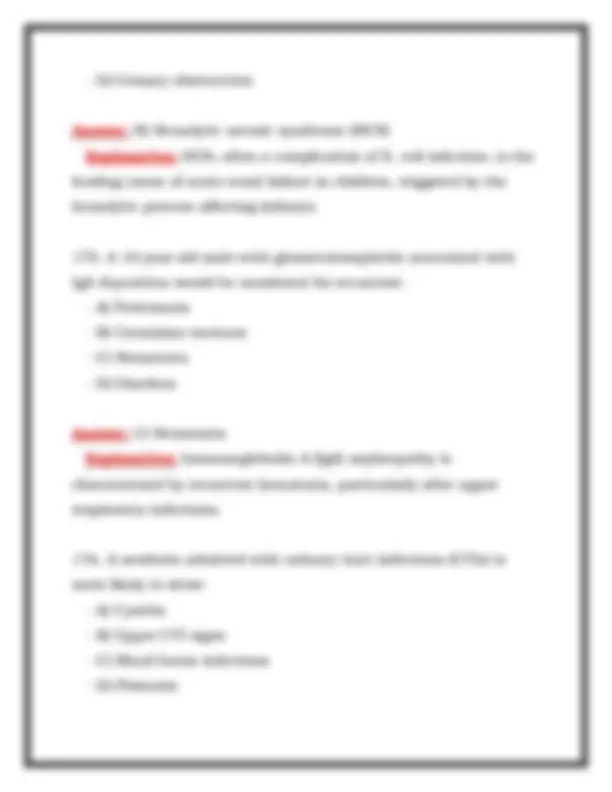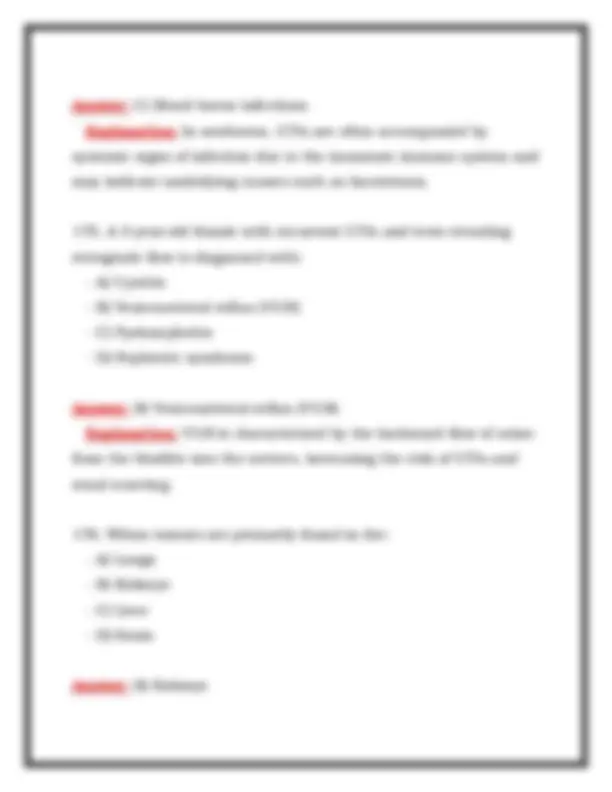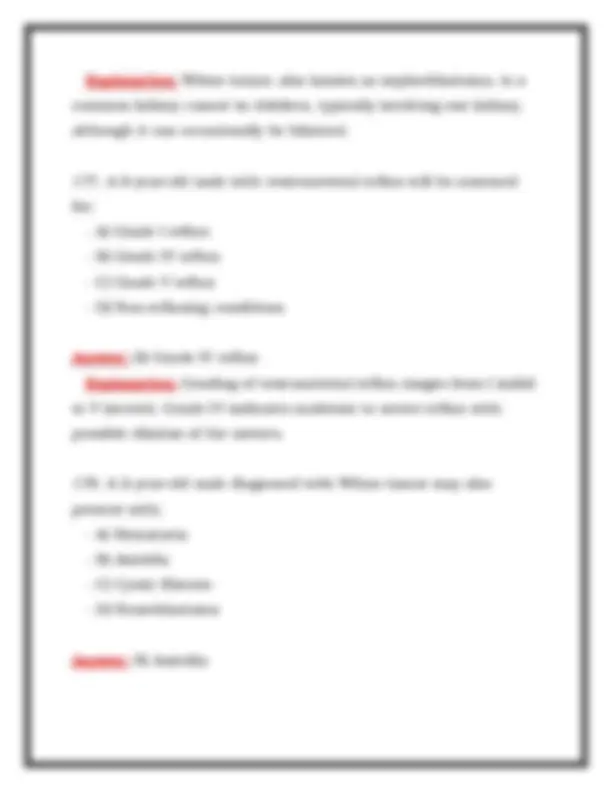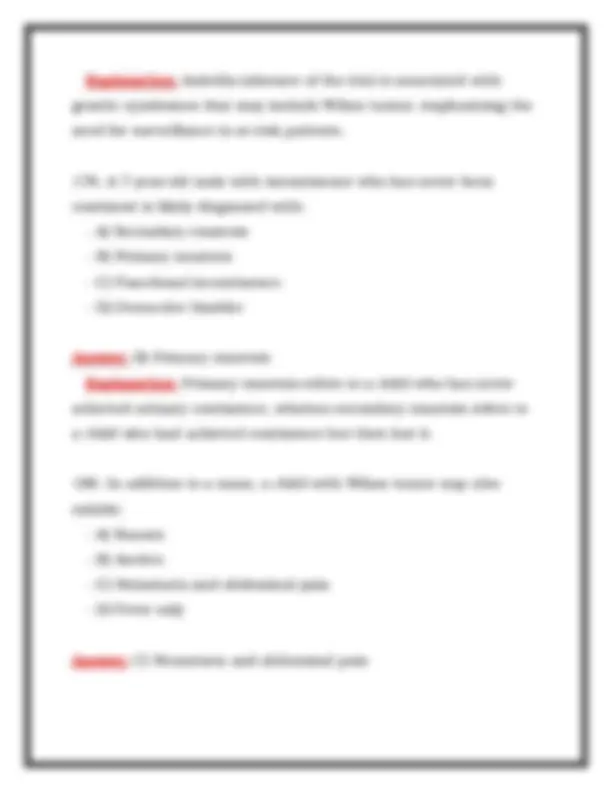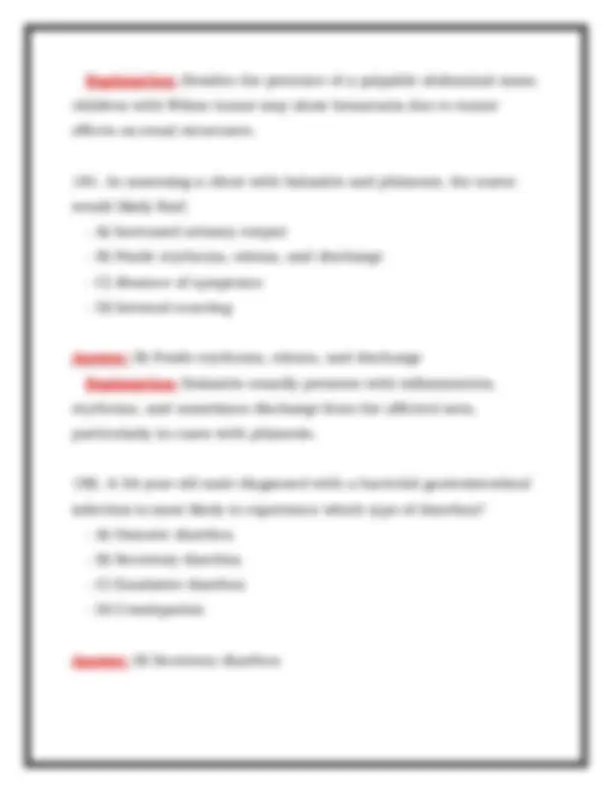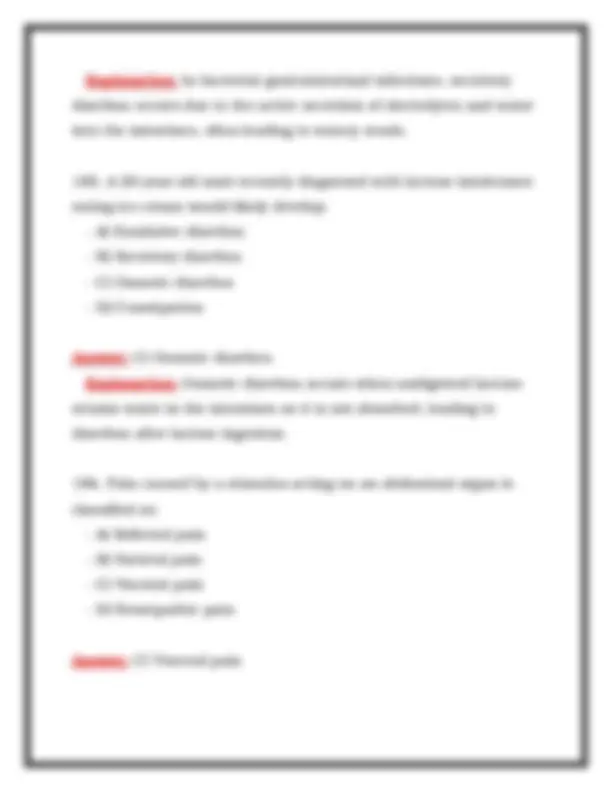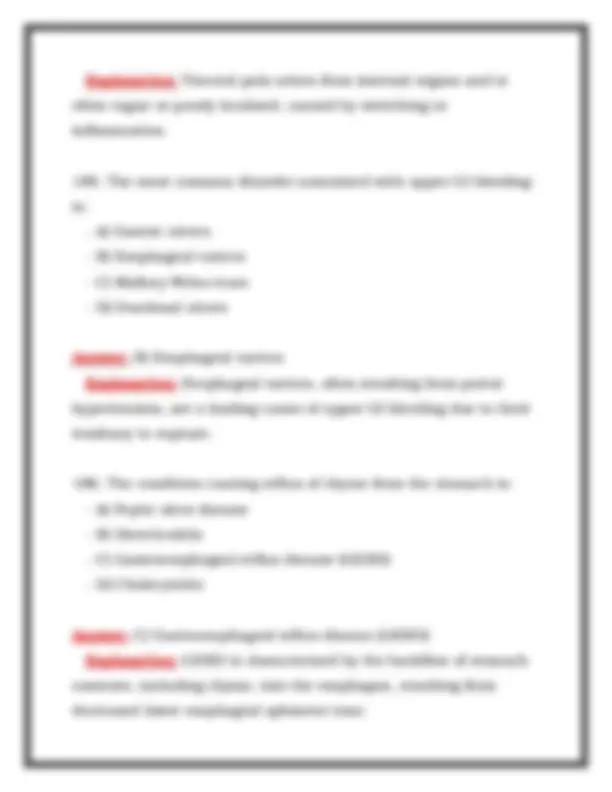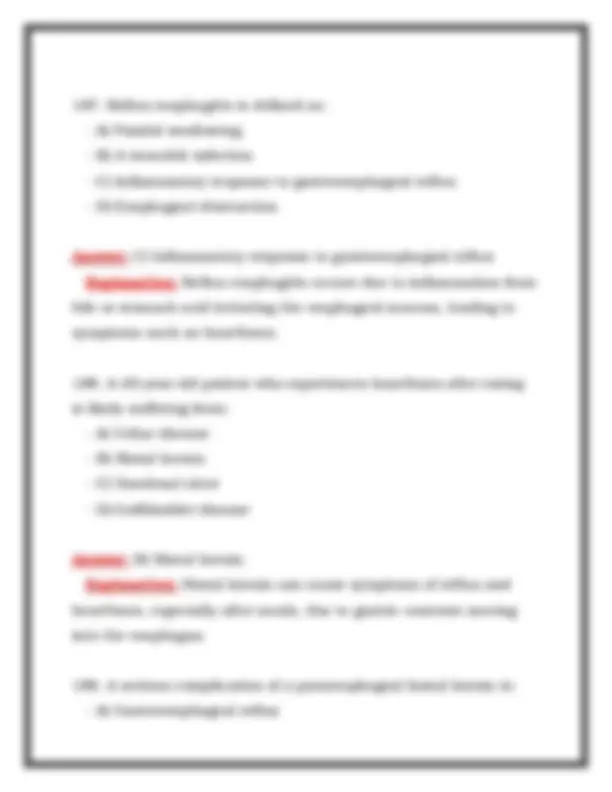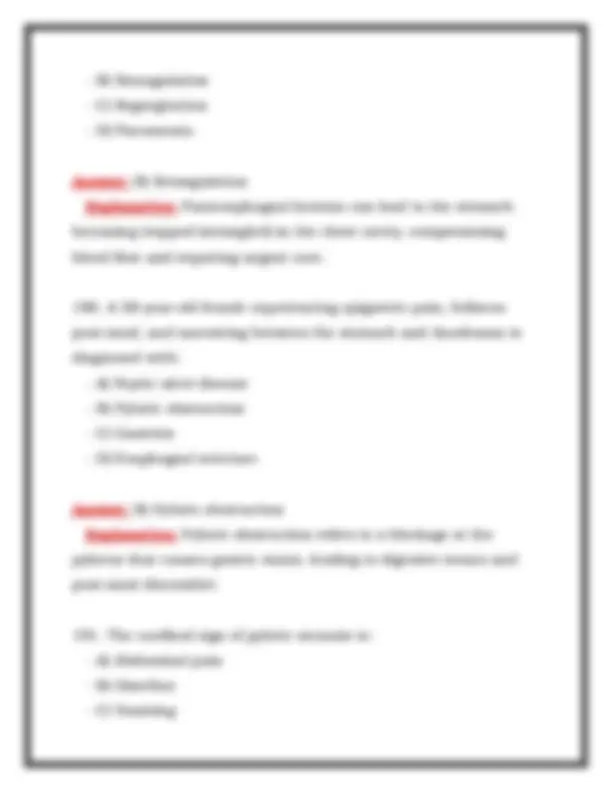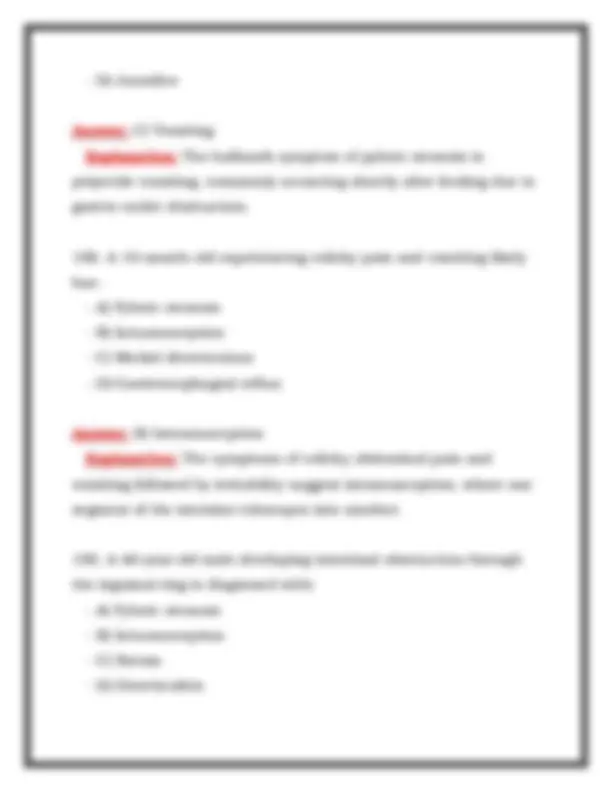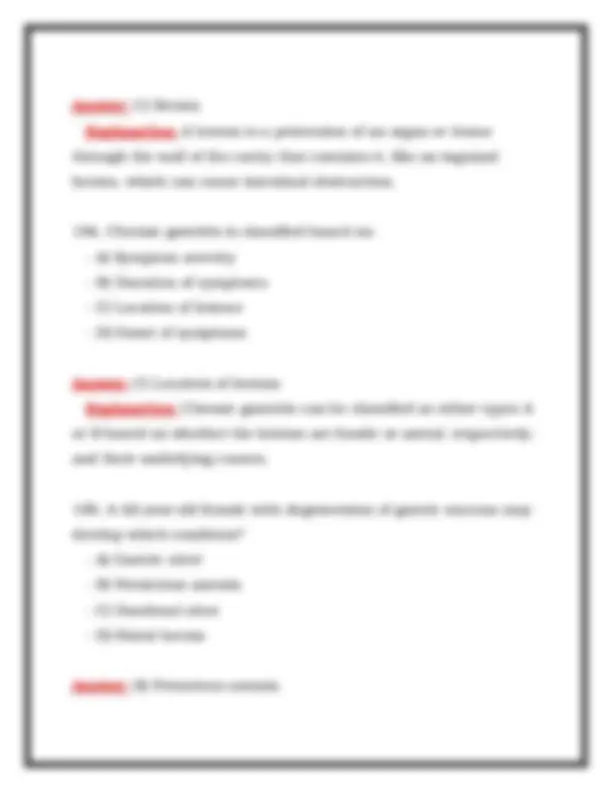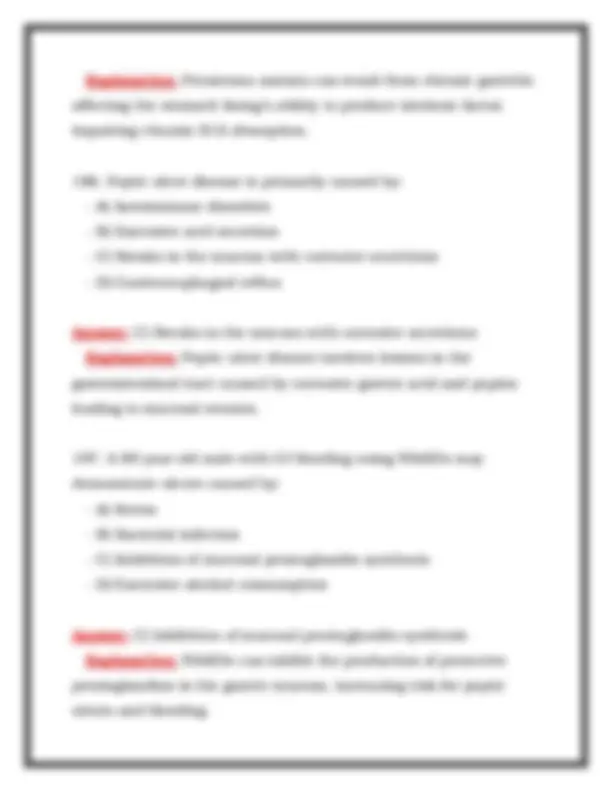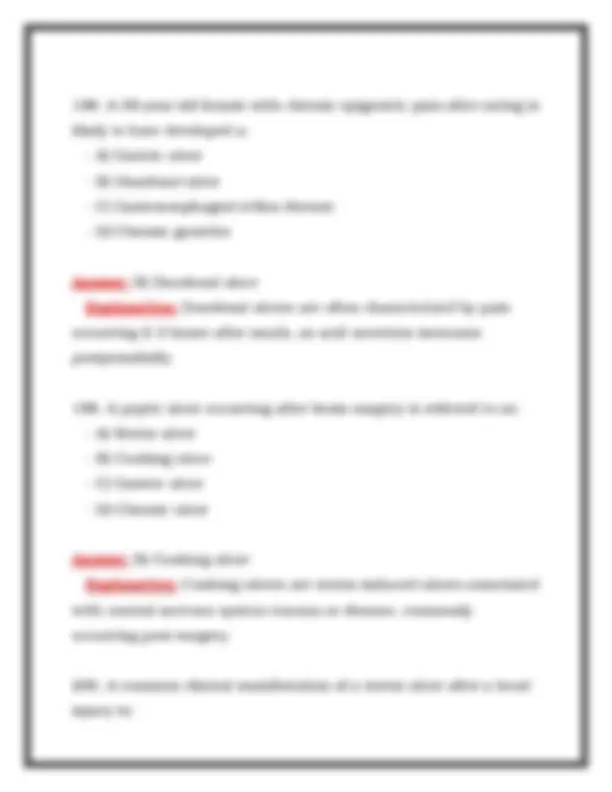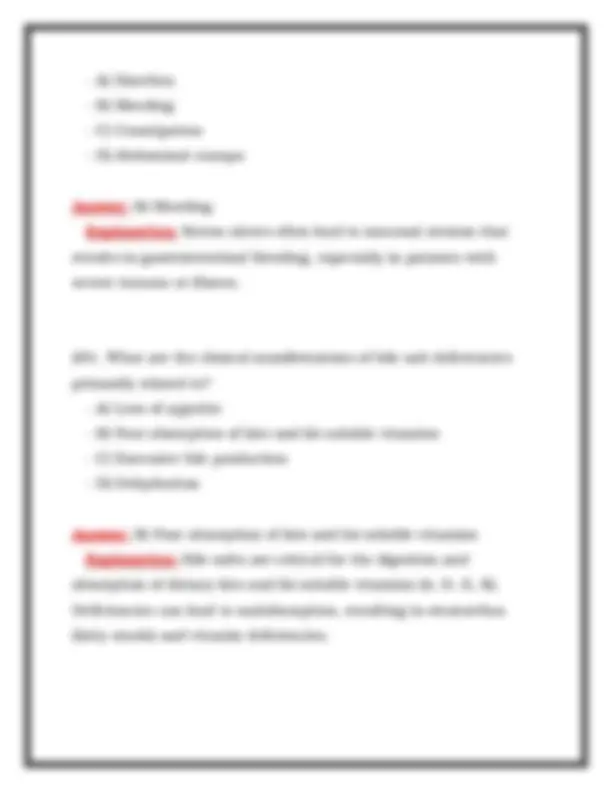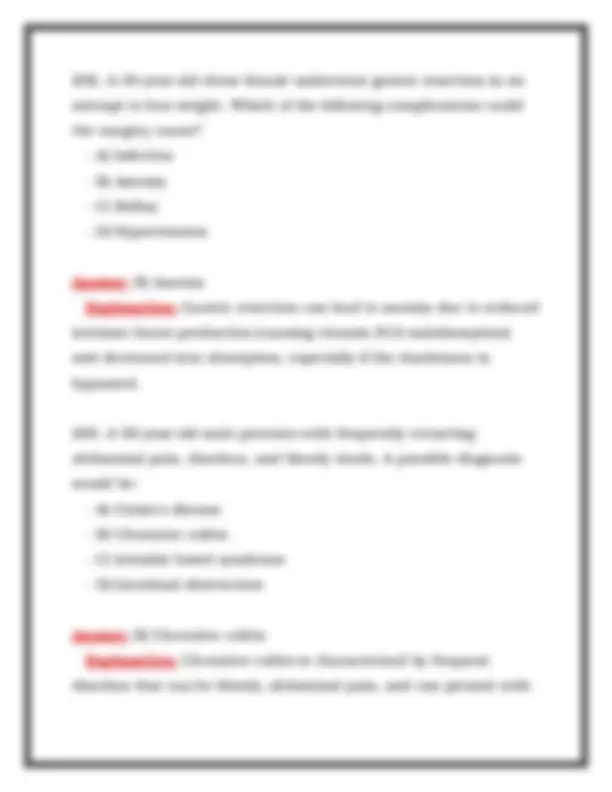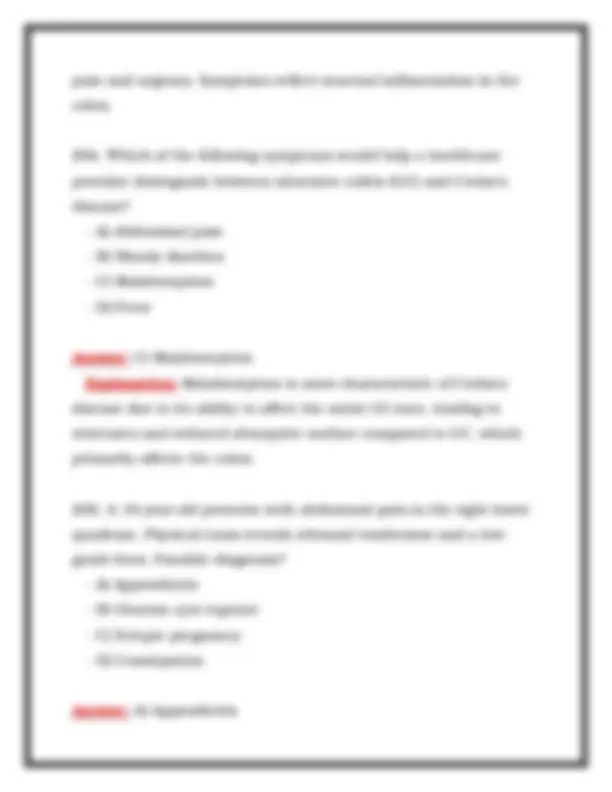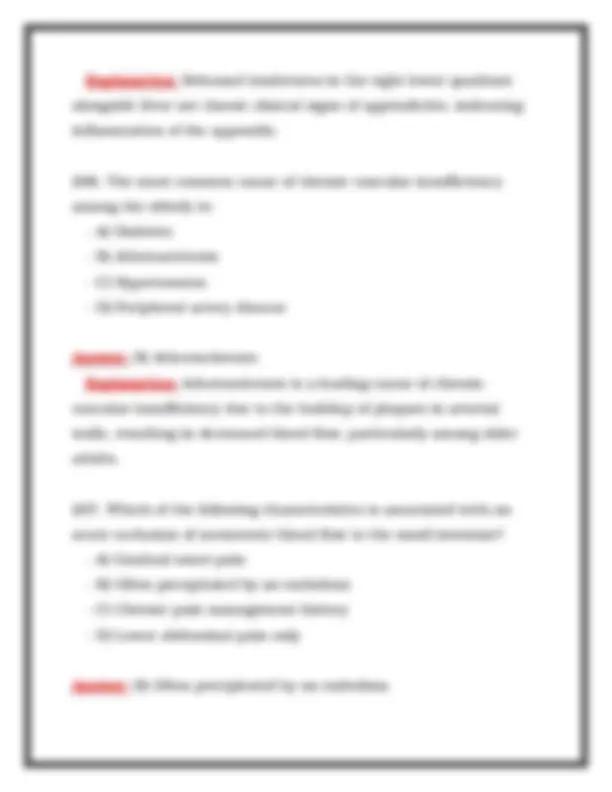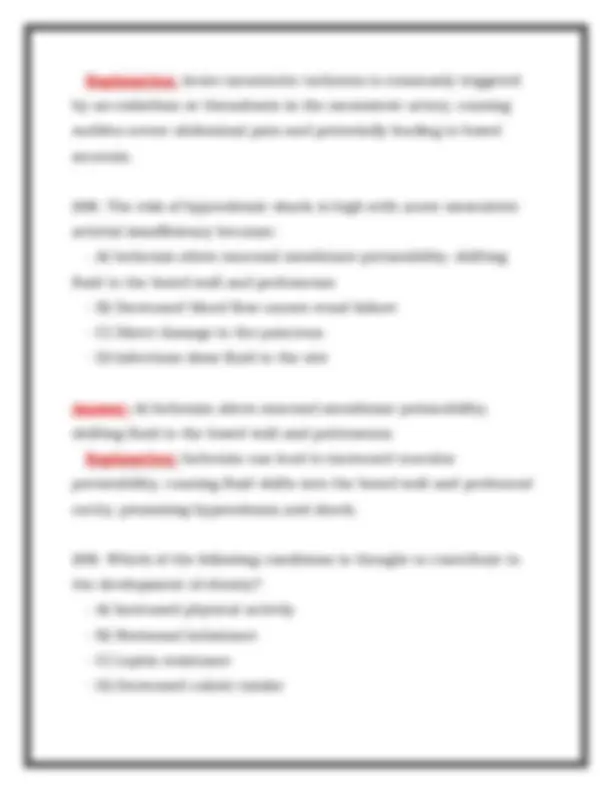Download NSG530 / NSG 530 Exam 3 Advanced Pathophysiology - Wilkes Actual Questions and Answers and more Exams Pathophysiology in PDF only on Docsity!
NSG530 / NSG 530 Exam 3
Advanced Pathophysiology - Wilkes
Actual Questions and Answers
100% Guarantee Pass
This Exam contains:
100% Guarantee Pass. Multiple-Choice (A–D), For Each Question. Each Question Includes The Correct Answer Expert-Verified explanation
1.What is the classification of an ovarian cyst that contains skin, hair, cartilage, and bone?
- A) Follicular Cyst
- B) Dermoid Cyst
- C) Functional Cyst
- D) Corpus Luteum Cyst Answer: B) Dermoid Cyst Explanation: Dermoid cysts, also known as mature teratomas, can contain various types of tissues derived from all three germ layers (ectoderm, mesoderm, endoderm), and thus may have skin, hair, and even bone components. 2.In treating a patient with endometriosis, which aspect of physiology would you want to suppress?
- A) Menstruation
- B) Ovulation
- C) Estrogen levels
- D) Progesterone levels Answer: B) Ovulation Explanation: Suppressing ovulation can lower estrogen levels in the body, which may alleviate the proliferation of endometrial tissue and the associated symptoms of endometriosis.
- A) Hepatocellular
- B) Hemolytic
- C) Obstructive
- D) Neonatal Answer: B) Hemolytic Explanation: Hemolytic jaundice occurs due to excess breakdown of red blood cells, resulting in the production of bilirubin that overwhelms the liver's ability to process it. 6.What is the most common disorder associated with upper GI bleeding?
- A) Peptic Ulcer Disease
- B) Esophageal Varices
- C) Gastritis
- D) Mallory-Weiss Tear Answer: B) Esophageal Varices Explanation: Esophageal varices, engorged veins in the esophagus due to portal hypertension, are a leading cause of upper GI bleeding, particularly in patients with liver cirrhosis. 7.You are examining a 6-month-old patient with jaundice, clay- colored stool, and failure to gain weight. You suspect biliary atresia. What is the most likely treatment for this disorder?
- A) Surgical correction
- B) Liver transplant
- C) Chemotherapy
- D) Nutrition therapy Answer: B) Liver transplant Explanation: Biliary atresia is often treated with a liver transplant as the condition involves an obstruction of bile ducts, leading to liver damage. 8.What is the most likely cause of genital warts?
- A) Herpes Simplex Virus
- B) Human Immunodeficiency Virus
- C) Human Papillomavirus (HPV)
- D) Cytomegalovirus Answer: C) Human Papillomavirus (HPV) Explanation: Genital warts are primarily caused by low-risk strains of HPV, particularly types 6 and 11. 9.What renal tissue is affected by pyelonephritis?
- A) Cortex only
- B) Renal pelvis and kidney interstitium
- C) Glomeruli only
- D) Renal tubules only Answer: B) Renal pelvis and kidney interstitium
Explanation: Stress incontinence occurs when an increase in intra-abdominal pressure leads to involuntary leakage of urine, commonly associated with weakened pelvic muscles. 12.What is the name of the disorder that may be seen in a male complaining of difficulty with sexual intercourse, stating his erect penis has a curved shape?
- A) Hydrocele
- B) Phimosis
- C) Peyronie's disease
- D) Varicocele Answer: C) Peyronie's disease Explanation: Peyronie's disease is characterized by the development of fibrous scar tissue in the penis, which causes curved and painful erections. 13.Your 53-year-old male patient reports frequent bouts of abdominal pain, diarrhea, and bloody stools. What is a likely diagnosis?
- A) Crohn's disease
- B) Ulcerative colitis
- C) Gastroenteritis
- D) Diverticulitis Answer: B) Ulcerative colitis
Explanation: Ulcerative colitis is a chronic inflammatory bowel disease that causes ulceration of the colonic mucosa, leading to diarrhea, abdominal pain, and rectal bleeding. 14.Where would you expect to find a Wilms tumor?
- A) Liver
- B) Kidney
- C) Lungs
- D) Ovary Answer: B) Kidney Explanation: Wilms tumor, or nephroblastoma, is a pediatric kidney cancer most commonly found in children aged 3 to 4 years. 15.What is the underlying cause of hepatic encephalopathy found in patients with chronic liver disease?
- A) Portal hypertension
- B) Impaired ammonia metabolism
- C) Excessive bilirubin levels
- D) Liver cell regeneration Answer: B) Impaired ammonia metabolism Explanation: Impaired ammonia metabolism due to liver dysfunction leads to the accumulation of ammonia in the bloodstream, which can affect brain function.
18.You have a patient with rebound tenderness in the right lower quadrant. What would you consider for a possible diagnosis?
- A) Cholecystitis
- B) Appendicitis
- C) Pancreatitis
- D) Diverticulitis Answer: B) Appendicitis Explanation: Rebound tenderness, particularly in the right lower quadrant, is a classic sign of appendicitis, indicating irritation of the peritoneum. 19.Your patient with a history of GERD reports increased heartburn after eating and now has difficulty swallowing. What problem do you think he may have?
- A) Hiatal hernia
- B) Esophageal stricture
- C) Esophagitis
- D) Achalasia Answer: B) Esophageal stricture Explanation: Difficulty swallowing (dysphagia) and increased heartburn may indicate an esophageal stricture, often caused by chronic reflux injury.
20.What is the most common type of cancer in the female reproductive tract?
- A) Cervical cancer
- B) Ovarian cancer
- C) Endometrial cancer
- D) Vulvar cancer Answer: C) Endometrial cancer Explanation: Endometrial cancer is the most prevalent cancer of the female reproductive system, often associated with unopposed estrogen stimulation. 21.Your patient displays symptoms of prostatitis. What differential diagnosis would you consider?
- A) Urethritis
- B) Bladder cancer
- C) Urinary tract infection; benign prostatic hyperplasia (BPH); prostate cancer
- D) Testicular cancer Answer: C) Urinary tract infection; benign prostatic hyperplasia (BPH); prostate cancer Explanation: Prostatitis can result from infections and can present similarly to BPH or even prostate cancer, making these vital considerations in differential diagnosis.
Explanation: PCOS is associated with insulin resistance and fertility issues; management includes lifestyle modifications and monitoring for metabolic complications. 24.What lab test would you order to confirm a diagnosis of PCOS?
- A) Thyroid function tests
- B) Hormone levels (excess androgen); insulin resistance
- C) Complete blood count
- D) Lipid profile Answer: B) Hormone levels (excess androgen); insulin resistance Explanation: Diagnosing PCOS includes checking for elevated androgen levels and evaluating insulin resistance through fasting insulin levels or glucose tolerance tests. 25.What are the sequelae of a Wilms tumor?
- A) Diabetes, hypertension
- B) Aniridia, hemihyperplasia, genitourinary malformations
- C) Osteoporosis, arthritis
- D) Cardiomyopathy, ventricular tachycardia Answer: B) Aniridia, hemihyperplasia, genitourinary malformations Explanation: Wilms tumor can be associated with certain congenital abnormalities, making surveillance for these conditions a priority in affected children.
26.You are examining a 5-month-old male with a sudden onset of abdominal pain, irritability, vomiting, and currant jelly-like stool. What type of obstruction is this?
- A) Volvulus
- B) Intussusception
- C) Pyloric stenosis
- D) Inguinal hernia Answer: B) Intussusception Explanation: Intussusception occurs when a part of the intestine telescopes into another, often leading to obstruction and characteristic symptoms. 27.Mesenteric arterial insufficiency places the patient at risk of hypovolemic shock. What is the mechanism of action leading to this possible outcome?
- A) Increased blood viscosity
- B) Alters mucosal membrane permeability, shifting fluid to the bowel wall and peritoneum
- C) Direct vasodilation of mesenteric arteries
- D) Decreased gastrointestinal motility Answer: B) Alters mucosal membrane permeability, shifting fluid to the bowel wall and peritoneum
30.What microorganism is the most common cause of urinary tract infections (UTIs)?
- A) Staphylococcus saprophyticus
- B) Enterococcus faecalis
- C) Escherichia coli
- D) Klebsiella pneumoniae Answer: C) Escherichia coli Explanation: E. coli is the principal pathogen responsible for the majority of urinary tract infections, particularly in females. 31.A male patient reports tenderness in his penis and that he is unable to retract the foreskin. What is the likely diagnosis?
- A) Phimosis
- B) Paraphimosis
- C) Balanitis
- D) Epididymitis Answer: A) Phimosis Explanation: Phimosis occurs when the foreskin cannot be retracted over the glans penis, often leading to discomfort or infection. 32.What is the classification of pain noted with stimulation of an abdominal organ?
- A) Somatic pain
- B) Neuropathic pain
- C) Visceral pain
- D) Referred pain Answer: C) Visceral pain Explanation: Visceral pain arises from internal organs and is often poorly localized, making it more generalized and difficult for patients to describe. 33.What pancreatic enzyme is deficient in pancreatic exocrine insufficiency?
- A) Amylase
- B) Trypsin
- C) Lipase
- D) Sucrase Answer: C) Lipase Explanation: Lipase is crucial for the digestion of fats, and its deficiency in pancreatic exocrine insufficiency leads to fat malabsorption. 34.What is the most common symptom of Meckel diverticulum?
- A) Abdominal pain
- B) Nausea and vomiting
- C) Painless rectal bleeding
Explanation: The glomerular filtration rate (GFR) is a key indicator of renal function, with lower values indicating renal impairment. 37.What is the most common bacterial sexually transmitted infection (STI) in the US?
- A) Syphilis
- B) Chlamydia
- C) Gonorrhea
- D) Trichomoniasis Answer: B) Chlamydia Explanation: Chlamydia is the most prevalent bacterial STI, commonly affecting young adults and often asymptomatic. 38.What is the most common symptom of a peptic ulcer?
- A) Diarrhea
- B) Burning stomach pain; relief after food
- C) Nausea
- D) Constipation Answer: B) Burning stomach pain; relief after food Explanation: Patients with peptic ulcers often describe epigastric pain that improves with eating, indicating a complex relationship between food intake and gastric secretions.
39.What microorganism is the underlying cause of yeast vaginitis?
- A) Trichomonas vaginalis
- B) Gardnerella vaginalis
- C) Candida albicans
- D) Mycoplasma hominis Answer: C) Candida albicans Explanation: Candida albicans is a common fungal pathogen that leads to yeast infections in the vaginal region. 40.What STI could result in neurological symptoms, including blindness?
- A) Gonorrhea
- B) Chlamydia
- C) Syphilis
- D) HPV Answer: C) Syphilis Explanation: Late stages of syphilis can lead to systemic manifestations, including neurological involvement, and can cause conditions such as tabes dorsalis that result in blindness. 41.A female patient previously diagnosed with PMS presents with exaggerated feelings of depression and moodiness; abdominal, back, and pelvic pain; and fatigue. Which of the following phases of the menstrual cycle is she most likely experiencing?

